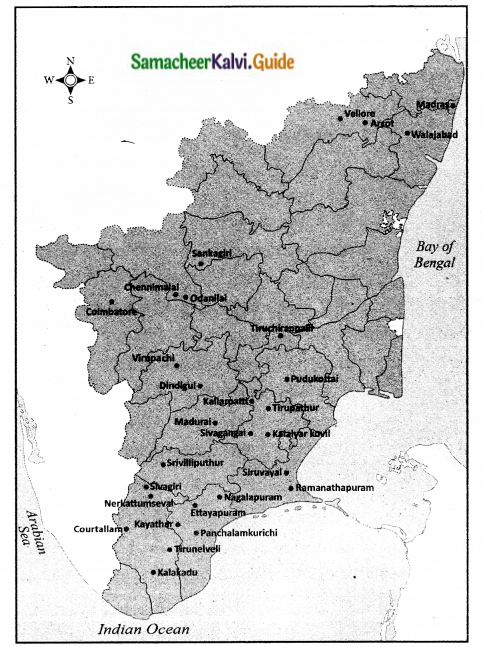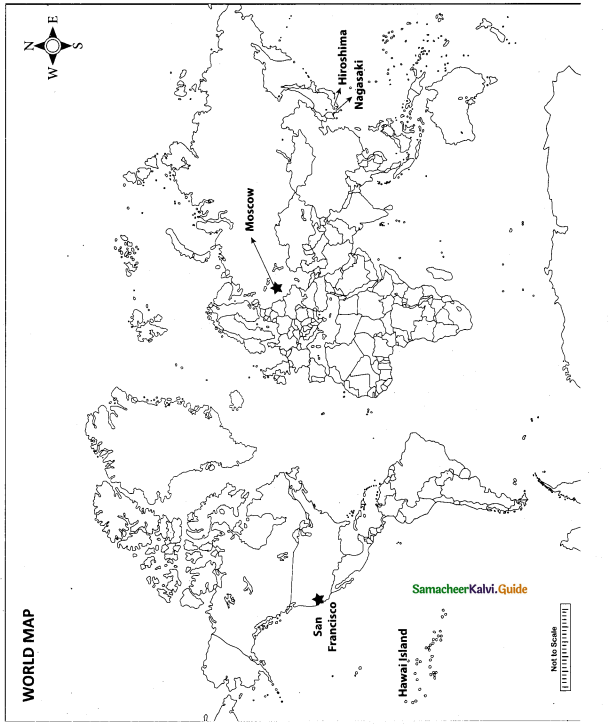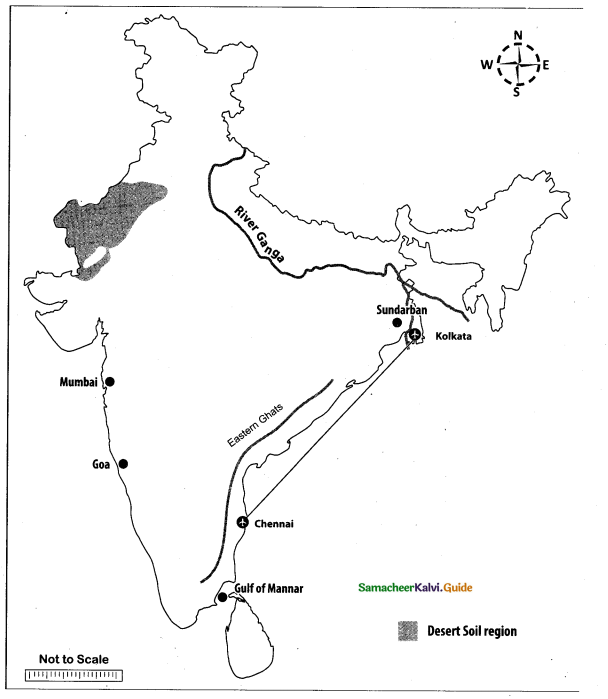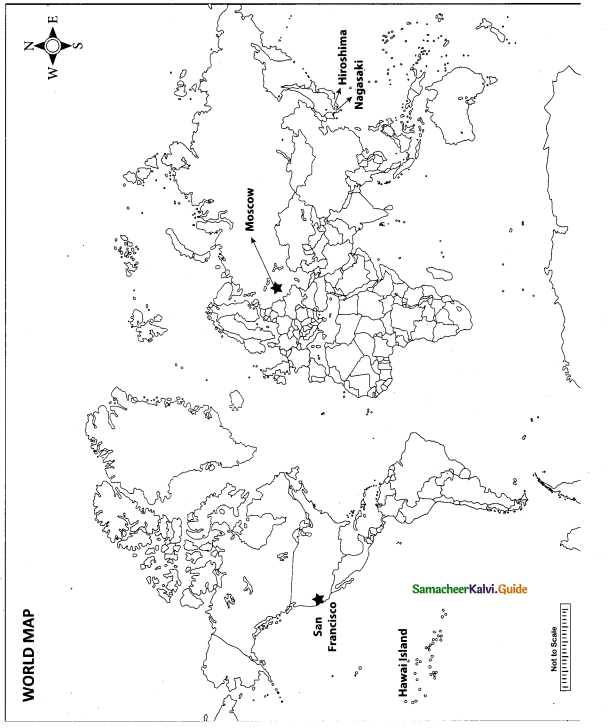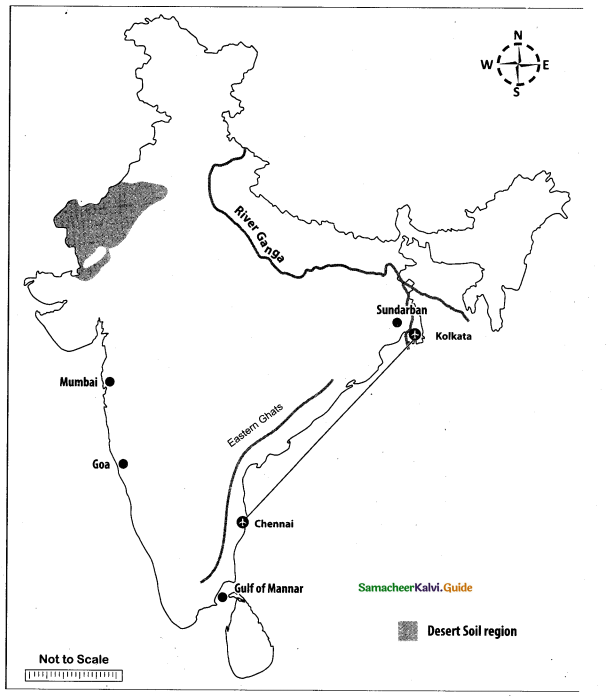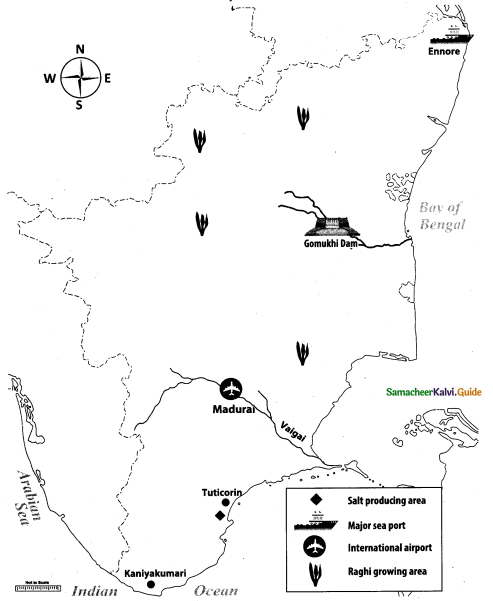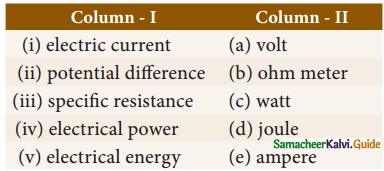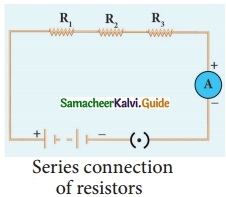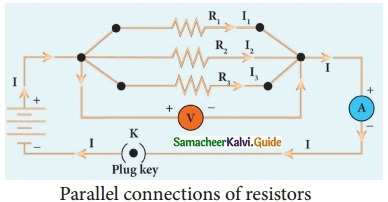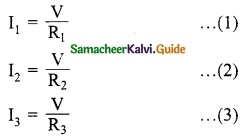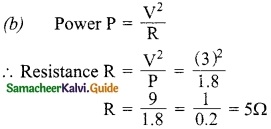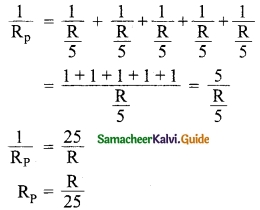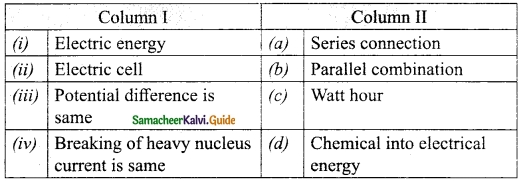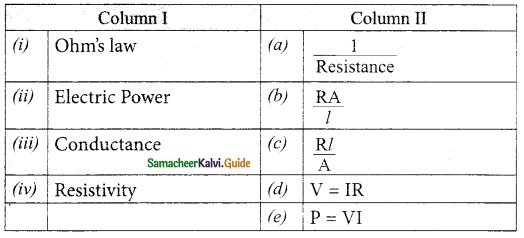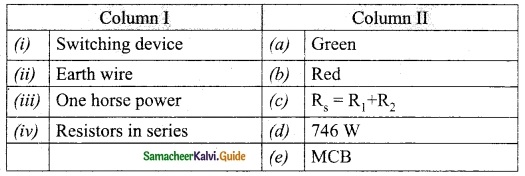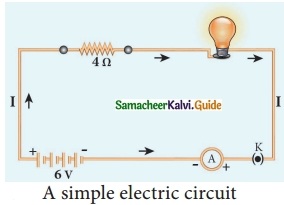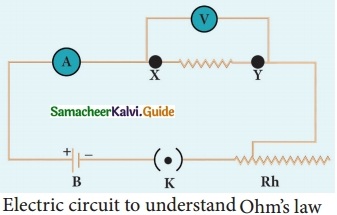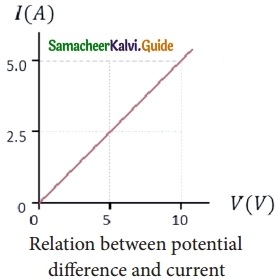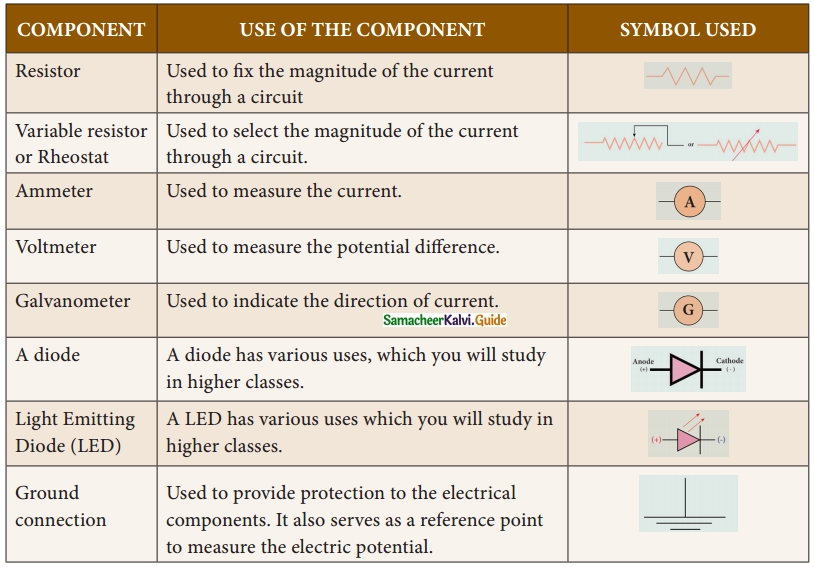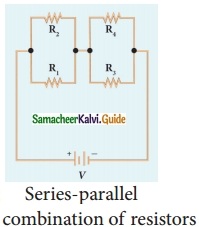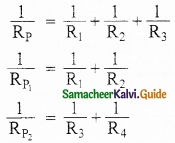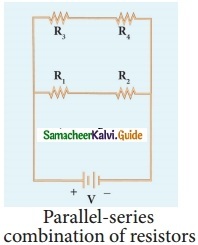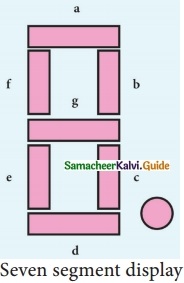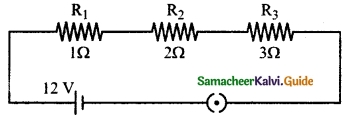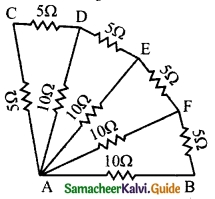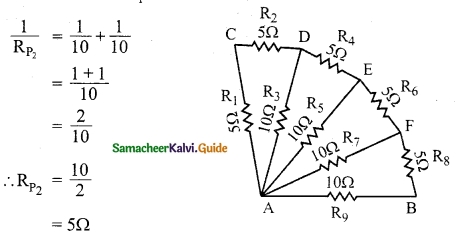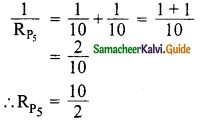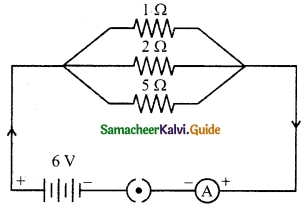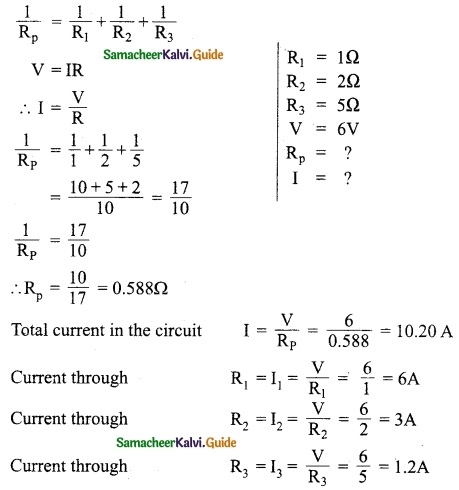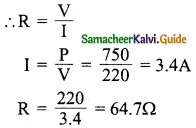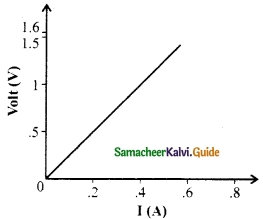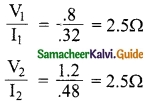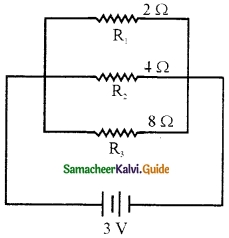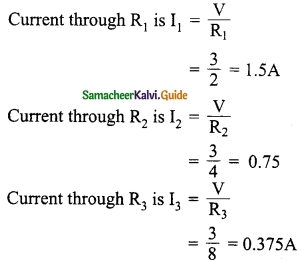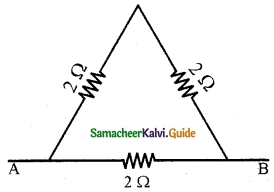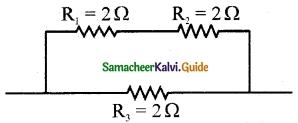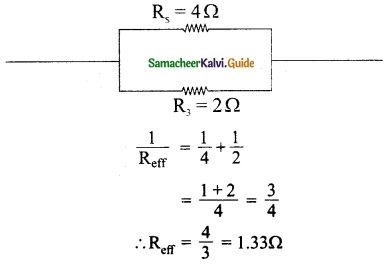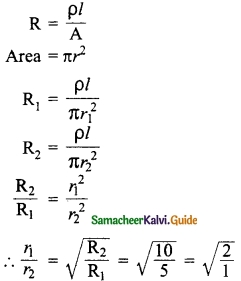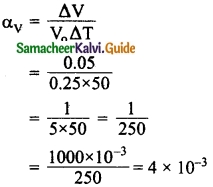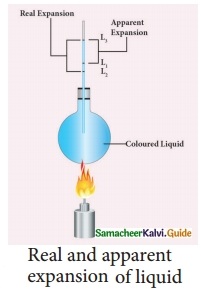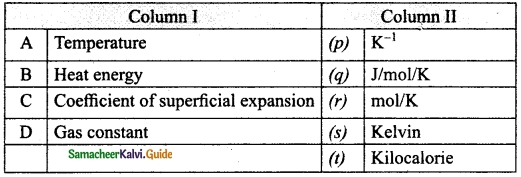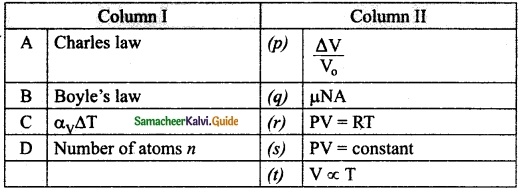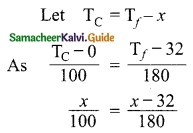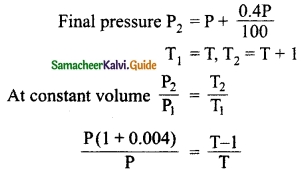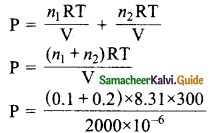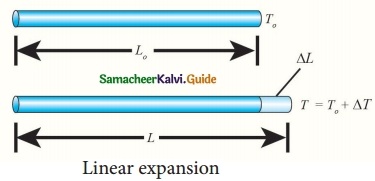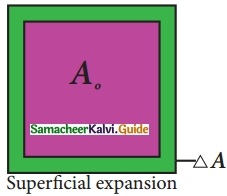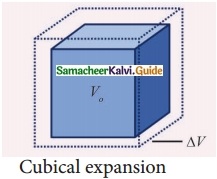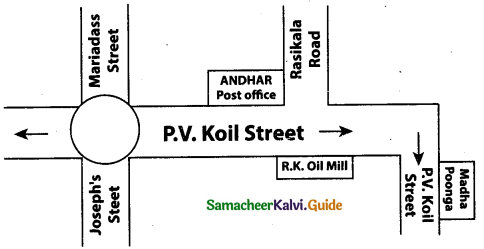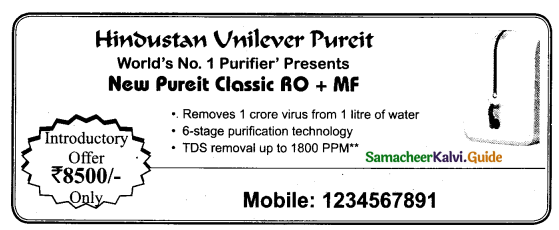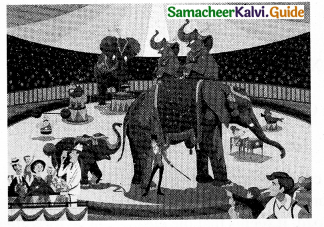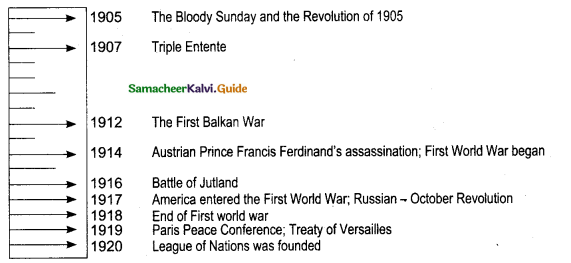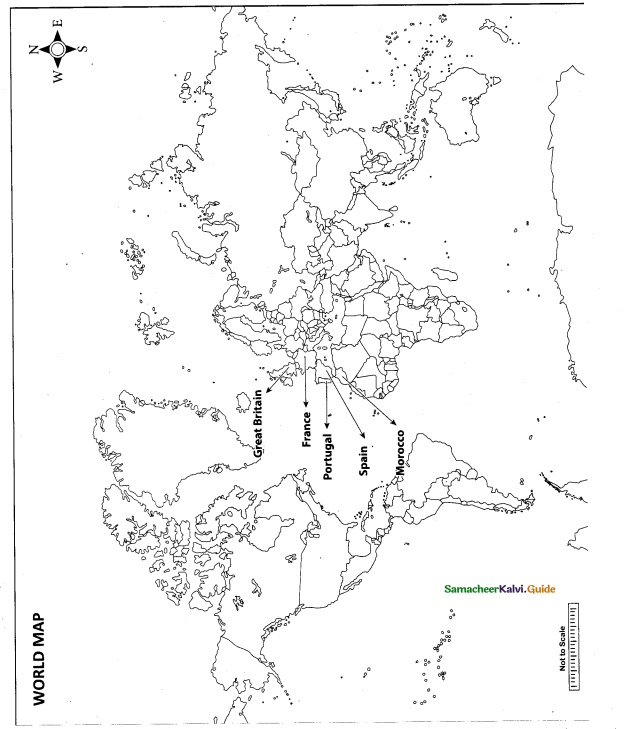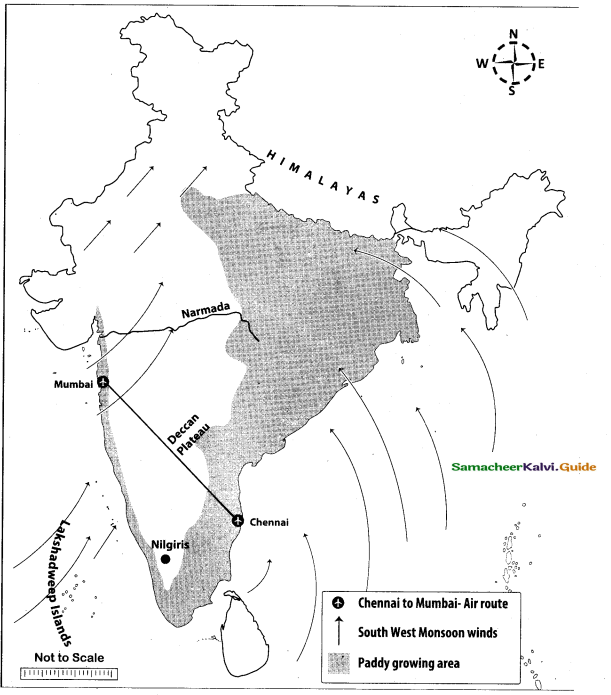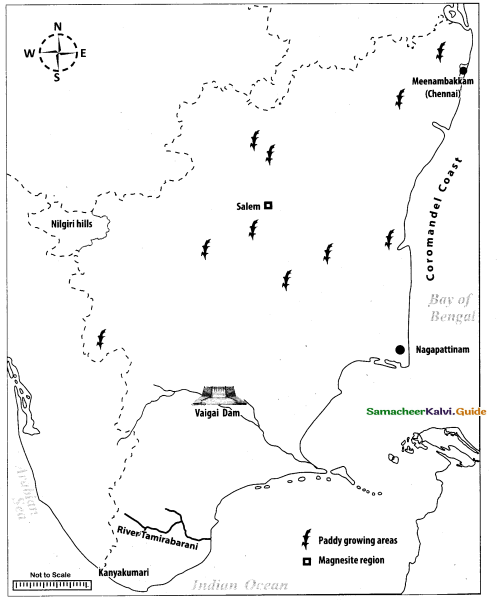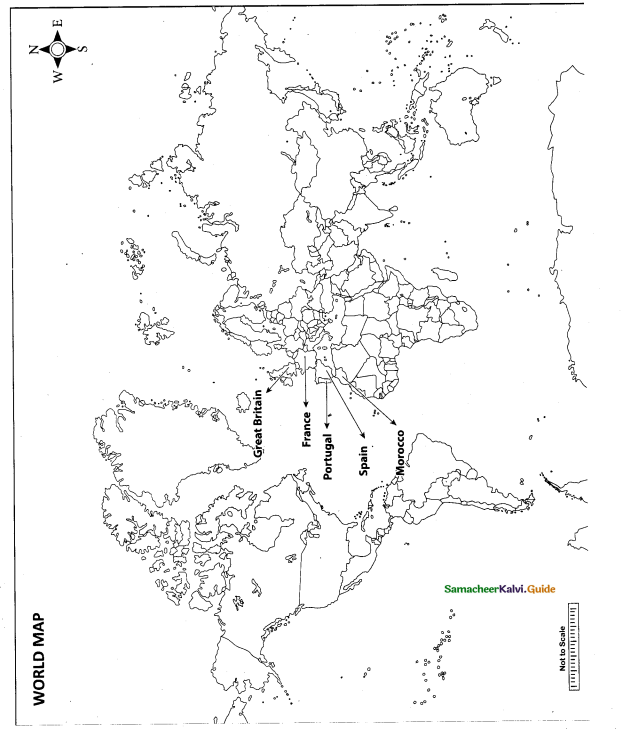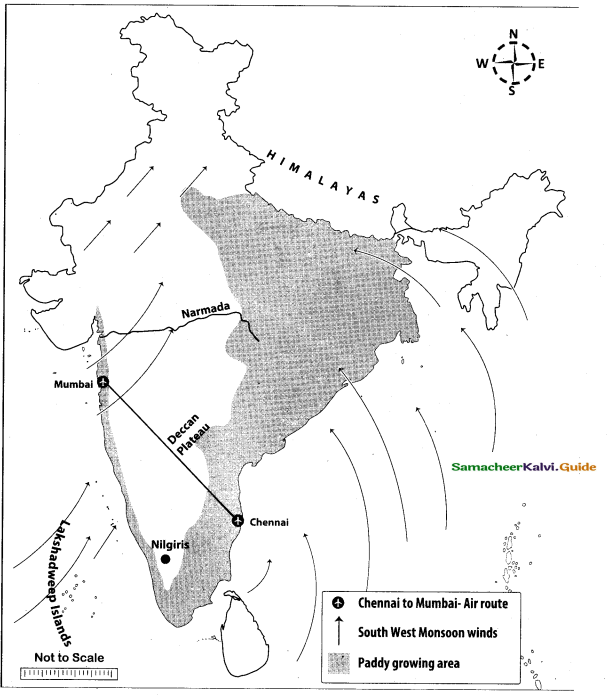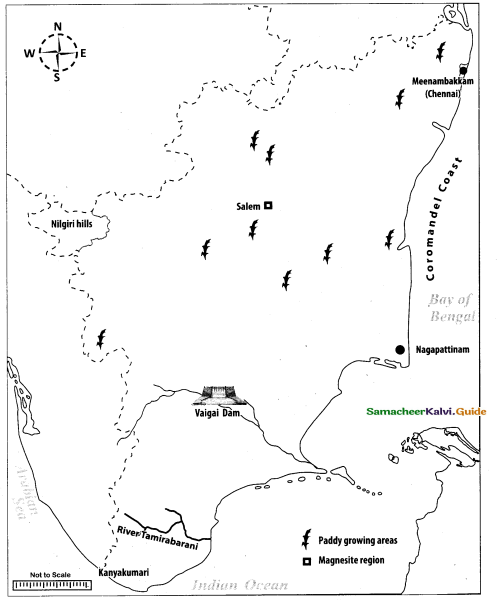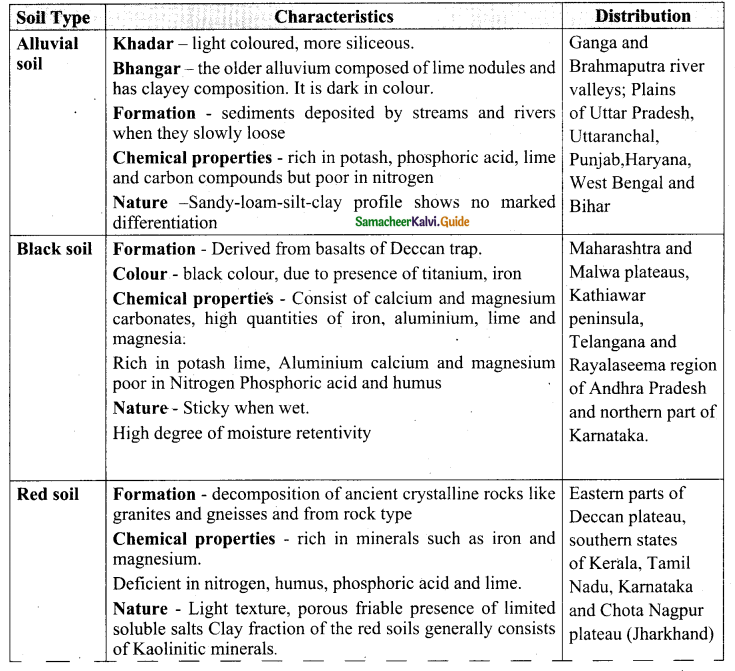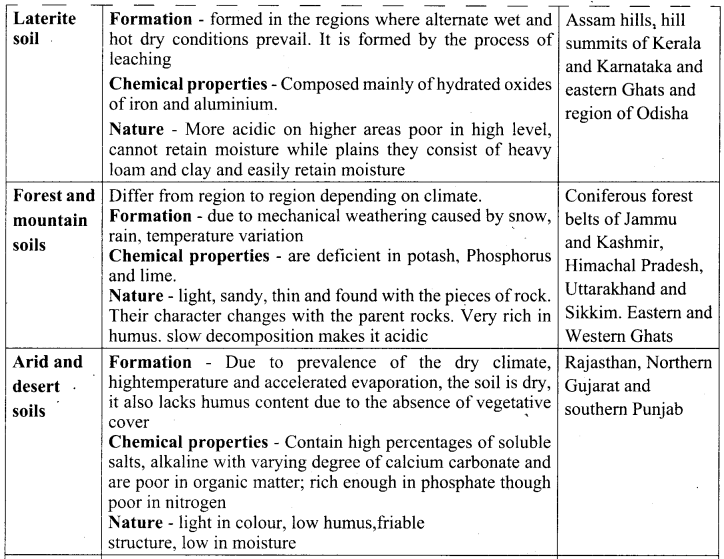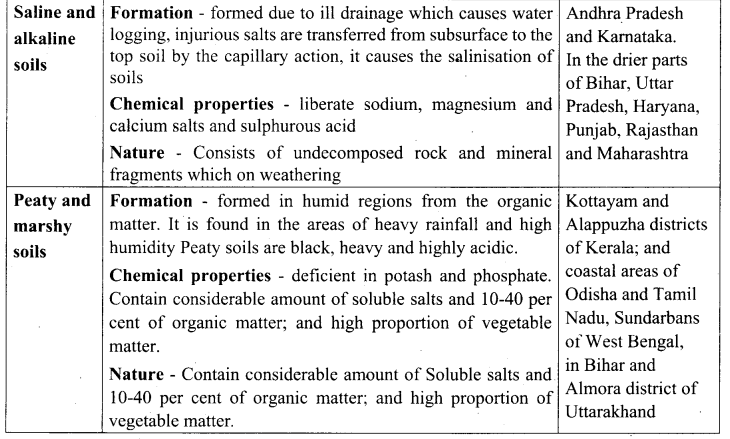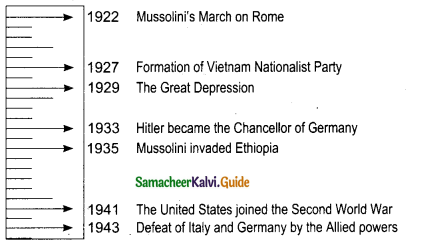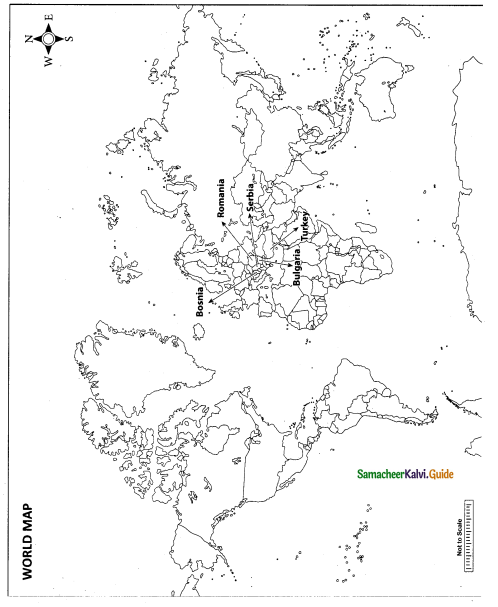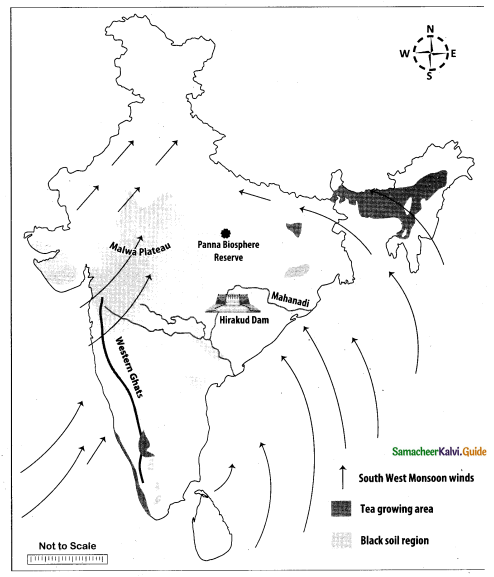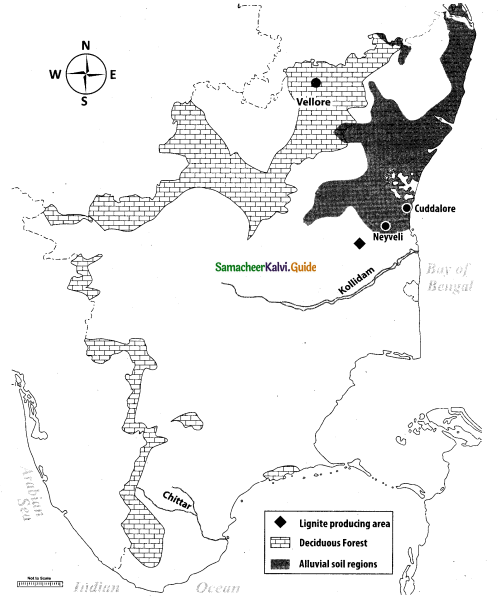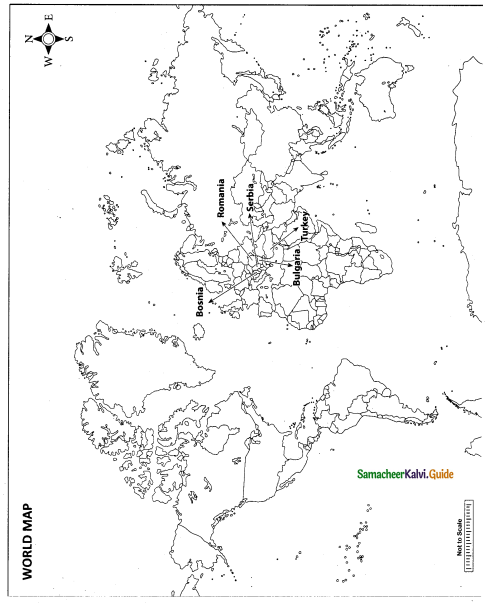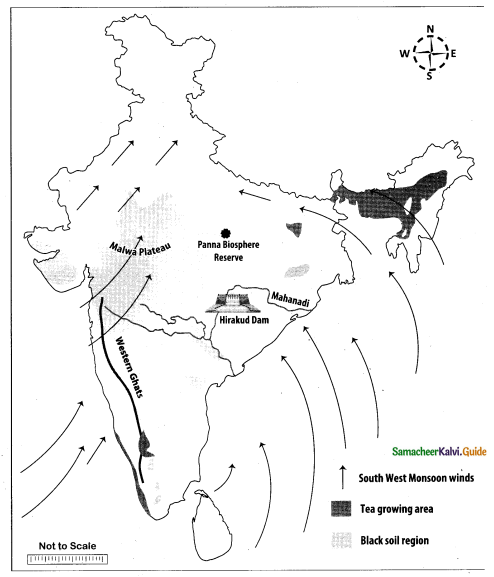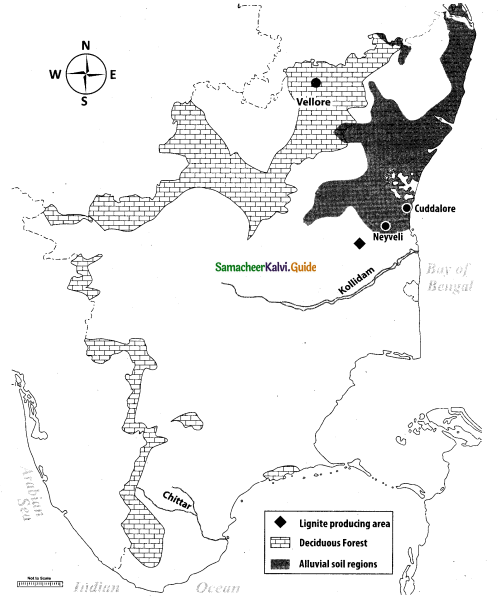Students can Download Samacheer Kalvi 10th Tamil Model Question Paper 3 Pdf, Samacheer Kalvi 10th Tamil Model Question Papers helps you to revise the complete Tamilnadu State Board New Syllabus, helps students complete homework assignments and to score high marks in board exams.
Tamil Nadu Samacheer Kalvi 10th Tamil Model Question Paper 3
நேரம்: 3.00 மணி
மதிப்பெண்கள் : 100
(குறிப்புகள்:
- இவ்வினாத்தாள் ஐந்து பகுதிகளைக் கொண்டது. அனைத்து பகுதிகளுக்கும் விடையளிக்க – வேண்டும். தேவையான இடங்களில் உள் தேர்வு வினாக்கள் கொடுக்கப்பட்டுள்ளது. காக
- பகுதி I, II, III, IV மற்றும் Vல் உள்ள அனைத்து வினாக்களுக்குத் தனித்தனியே விடையளிக்க வேண்டும்.
- வினா எண். 1 முதல் 15 வரை பகுதி-1ல் தேர்வு செய்யும் வினாக்கள் தரப்பட்டுள்ளன. ஒவ்வொரு வினாவிற்கும் ஒரு மதிப்பெண். சரியான விடையைத் தேர்ந்தெடுத்து குறியீட்டுடன் எழுதவும்.
- வினா எண் 16 முதல் 28 வரை பகுதி-IIல் இரண்டு மதிப்பெண் வினாக்கள் தரப்பட்டுள்ளன: ஏதேனும் 9 வினாக்களுக்கு மட்டும் விடையளிக்கவும்.
- வினா எண் 29 முதல் 37 வரை பகுதி-IIIல் மூன்று மதிப்பெண் வினாக்கள் தரப்பட்டுள்ளன. –
ஏதேனும் 6 வினாக்களுக்கு மட்டும் விடையளிக்கவும். - வினா எண் 38 முதல் 42 வரை பகுதி-IVல் ஐந்து மதிப்பெண் வினாக்கள் தரப்பட்டுள்ளன. ஏதேனும் 5 வினாக்களுக்கு மட்டும் விடையளிக்கவும்.
- வினா எண் 43 முதல் 45 வரை பகுதி-Vல் எட்டு மதிப்பெண் வினாக்கள் தரப்பட்டுள்ளன. அனைத்து வினாவிற்கும் விடையளிக்கவும்.
பகுதி – 1 (மதிப்பெண்கள்: 15)
(i) அனைத்து வினாக்களுக்கும் விடையளிக்கவும்.
(ii) கொடுக்கப்பட்ட நான்கு விடைகளில் சரியான விடையினைத் தேர்ந்தெடுத்துக் குறியீட்டுடன் விடையினையும் சேர்த்து எழுதுக. [15 × 1 = 15]
(குறிப்பு: விடைகள் தடித்த எழுத்தில் உள்ளன.)
Question 1.
காசிக்காண்ட ம் என்பது …………………
(அ) காசி நகரத்தின் பெருமையைப் பாடும் நூல்
(ஆ) காசி நகரத்தைக் குறிக்கும் மறுபெயர்
(இ) காசி நகரத்தின் வரலாற்றைப் பாடும் நூல்
(ஈ) காசி நகரத்திற்கு வழிப்படுத்தும் நூல்
Answer:
(அ) காசி நகரத்தின் பெருமையைப் பாடும் நூல்
Question 2.
தொல்காப்பியம் குறிப்பிடும் இசைக்கருவி …………………
(அ) ஜால்ரா
(ஆ) உறுமி
(இ) பறை
(ஈ) நாகசுரம்
Answer:
(இ) பறை
Question 3.
அஃறிணையில்………….க் குறிப்பது ஒன்றன்பால் ஆகும்.
(அ) ஒன்றினை
(ஆ) இரண்டினை
(இ) மூன்றினை
(ஈ) நான்கினை
Answer:
(அ) ஒன்றினை
![]()
Question 4.
ஜெயகாந்தன் படைப்புகளில் சாகித்திய அகாதெமி விருதுபெற்ற நூல். …………………
(அ) யாருக்காக அழுதான்
(ஆ) சில நேரங்களில் சில மனிதர்கள்
(இ) உன்னைப் போல் ஒருவன்
(ஈ) ஒரு நடிகை நாடகம் பார்க்கிறாள்
Answer:
(ஆ) சில நேரங்களில் சில மனிதர்கள்
Question 5.
மெய்க்கீ ர்த்திகள்………..
(அ) புலவர்களால் எழுதப்பட்டுக் கல்தச்சர்களால் கல்லில் பொறிக்கப்பட்டவை
(ஆ) மக்களின் எண்ணங்களாகப் புகழ்ந்து பாடப்பட்டவை
(இ) இலக்கியங்களாக ஓலையில் எழுதப்பட்டவை
(ஈ) புகழைப் பரப்பும் வகையில் துணியில் எழுதப்பட்டவை
Answer:
(அ) புலவர்களால் எழுதப்பட்டுக் கல்தச்சர்களால் கல்லில் பொறிக்கப்பட்டவை
Question 6.
செய்தி 1 – ஒவ்வோர் ஆண்டும் ஜுன் 15 ஐ உலகக் காற்று நாளாகக் கொண்டாடி வருகிறோம்.
செய்தி 2 – காற்றாலை மின் உற்பத்தியில் இந்தியாவில் தமிழகம் இரண்டாமிடம் என்பது எனக்குப் பெருமையே.
செய்தி 3 – காற்றின் ஆற்றலைப் பயன்படுத்திக் கடல் கடந்து வணிகம் செய்து அதில் வெற்றி கண்டவர்கள் தமிழர்கள்.
(அ) செய்தி 1 மட்டும் சரி
(ஆ) செய்தி 1, 2 ஆகியன சரி
(இ) செய்தி 3 மட்டும் சரி
(ஈ) செய்தி 1, 3 ஆகியன சரி
Answer:
(இ) செய்தி 3 மட்டும் சரி
![]()
Question 7.
இலக்கண முறையுடன் பிழையின்றிப் பேசுவதும் எழுதுவதும்………….. எனப்ப டும்.
(அ) வழு
(ஆ) வழாநிலை
(இ) தொடர்நிலை
(ஈ) அறிமுகநிலை
Answer:
(ஆ) வழாநிலை
Question 8.
கொடுக்கப்பட்டுள்ள குறிப்புகளுக்குப் பொருத்தமான தலைப்பு எது?
குறிப்பு: (i) கண்காணிப்புக் கருவி, அசைவு நிகழும் பக்கம் தன் பார்வையைத் திருப்புகிறது.
(ii) திறன் பேசியில் உள்ள வரைபடம் போக்குவரத்திற்குச் சுருக்கமான வழியைக் காண்பிக்கிறது.
(அ) இணையம்
(ஆ) மடிக்கணினி
(இ) கணினி
(ஈ) செயற்கை நுண்ணறிவு
Answer:
(ஈ) செயற்கை நுண்ணறிவு
Question 9.
“வீட்டில் தக்காளி இல்லை, நீ கடைக்குச் செல்கிறாயா?” என்று அக்கா தம்பியிடம் கேட்பது …. வினா. அதற்கு, நான் போக மாட்டேன் எனத் தம்பி கூறுவது …………………விடை
(அ) அறிவினா, இனமொழி விடை
(ஆ) ஏவல் வினா, நேர்விடை
(இ) ஏவல்வினா, மறை விடை
(ஈ) ஐயவினா, சுட்டுவிடை
Answer:
(இ) ஏவல்வினா, மறை விடை
![]()
Question 10.
செய்யுளில் எழுவாய்களை வரிசைப்படுத்தி, அவை ஏற்கும் பயனிலைகளை எதிர் எதிராகக் கொண்டு பொருள் கொள்ளுதல்……………… ஆகும்.
(அ) கொண்டு கூட்டுப் பொருள்கோள்
(ஆ) எதிர் நிரல்நிறைப் பொருள்கோள்
(இ) ஆற்றுநீர்ப் பொருள்கோள்
(ஈ) நிரல்நிறைப் பொருள்கோள்
Answer:
(ஆ) எதிர் நிரல்நிறைப் பொருள்கோள்
Question 11.
காலக்கணிதம் கவிதையில் இடம்பெற்ற தொடர் …………………
(அ) இகழ்ந்தால் என்மனம் இறந்துவிடாது
(ஆ) என்மனம் இகழ்ந்தால் இறந்துவிடாது
(இ) இகழ்ந்தால் இறந்துவிடாது என்மனம்
(ஈ) இறந்துவிடாது இகழ்ந்தால் என்மனம்
Answer:
(அ) இகழ்ந்தால் என்மனம் இறந்துவிடாது
பாடலைப் படித்துப் பின்வரும் வினாக்களுக்கு (12, 13, 14, 15) விடை தருக.
“வண்ணமும் சுண்ணமும் தண்நறுஞ் சாந்தமும்
பூவும் புகையும் மேவிய விரையும்
பகர்வனர் திரிதிரு நகர வீதியும்;
பட்டினும் மயிரினும் பருத்தி நூலினும்
கட்டு நுண்வினைக் காருகர் இருக்கையும்;
தூசும் துகிரும் ஆரமும் அகிலும்”
Question 12.
பாடலில் அமைந்துள்ள மோனைச் சொற்கள் …………………
(அ) பகர்வனர், பட்டினும்
(ஆ) காருகர், துகிரும்
(இ) பட்டினும், மயிரினும்
(ஈ) நூலினும், அகிலும்
Answer:
(அ) பகர்வனர், பட்டினும்
Question 13.
இப்பாடலில் காணப்படும் நறுமணப் பொருள் ……………….
(அ) துகிர், தூசு
(ஆ) ஆரம், அகில்
(இ) சுண்ண ம், அகில்
(ஈ) பட்டு, பருத்தி
Answer:
(ஆ) ஆரம், அகில்
![]()
Question 14.
பாடலில் அமைந்துள்ள எதுகைச் சொற்கள் …………………
(அ) பட்டினும், கட்டு
(ஆ) தூசும், துகிரும்
(இ) ஆரமும், அகிலும்
(ஈ) மயிரினும், நூலினும்
Answer:
(அ) பட்டினும், கட்டு
Question 15.
பாடலில் அமைந்துள்ள இயைபுச் சொற்களை எழுதுக.
(அ) பட்டினும், கட்டு
(ஆ) பருத்தி, காருகர்
(இ) விரையும், வீதியும்
(ஈ) காருகர், மேவிய
Answer:
(இ) விரையும், வீதியும்
பகுதி – II (மதிப்பெண்க ள்: 18)
பிரிவு – 1
எவையேனும் நான்கு வினாக்களுக்கு மட்டும் குறுகிய விடையளிக்க.
21 ஆவது வினாவிற்குக் கட்டாயமாக விடையளிக்க வேண்டும். [4 × 2 = 8]
Question 16.
விடைக்கேற்ற வினா அமைக்க.
(அ) கண்ணதாசனின் கவிதைத் தொகுப்பில் இடம் பெற்ற பகுதியின் பெயர்
காலக்கணிதம் ஆகும்.
(ஆ) தொல்காப்பியர், ‘உலகம் என்பது ஐம்பெரும் பூதங்களால் ஆனது’ என்கிறார்.
Answer:
விடை:
(அ) கண்ணதாசனின் கவிதைத் தொகுப்பில் இடம் பெற்ற பகுதியின் பெயர் என்ன?
(ஆ) தொல்காப்பியர் உலகம் எவற்றால் ஆனது என்கிறார்?
Question 17.
பெருஞ்சித்திரனார் எழுதிய நூல்கள் யாவை?
Answer:
- உலகியல் நூறு
- பாவியக்கொத்து
- நூறாசிரியம்
- கனிச்சாறு
- எண்சுவை எண்பது
- மகபுகுவஞ்சி
- பள்ளிப்பறவைகள் முதலியனவாகும்.
Question 18.
மெய்க்கீர்த்தி பாடப்படுவதன் நோக்கம் யாது?
Answer:
அரசர்கள் தங்கள் வரலாறும் பெருமையும் காலம் கடந்தும் நிலைக்க விரும்பினார்கள்; அழியாத வகையில் அதனைக் கல்லில் செதுக்கினார்கள். சங்க இலக்கியமான பதிற்றுப்பத்துப் பாடல்களின் இறுதியிலுள்ள பதிகங்கள் இதற்கு முன்னோடி! பல்லவர் கல்வெட்டுகளிலும் பாண்டியர் செப்பேடுகளிலும் முளைவிட்ட இவ்வழக்கம், சோழர் காலத்தில் மெய்க்கீர்த்தி எனப் பெயர் பெற்றது; செப்பமான வடிவம் பெற்றது; கல் இலக்கியமாய் அமைந்தது.
Question 19.
நிகழ்கலை என்றால் என்ன?
Answer:
- சிற்றூர் மக்களின் வாழ்வியல் நிகழ்வுகளில் பிரித்துப் பார்க்க இயலாக் கூறுகளாகத் திகழ்பவை நிகழ்கலைகள்.
- மக்களுக்கு மகிழ்ச்சியெனும் கனி கொடுத்துக் கவலையைப் போக்குகின்றன.
- சமுதாய நிகழ்வுகளின் ஆவணங்களாகவும் செய்திகளைத் தரும் ஊடகங்களாகவும் . திகழ்கின்றன
- பழந்தமிழ் மக்களின் கலை, அழகியல், புதுமை ஆகியவற்றின் எச்சங்களை அறிவதற்குத் தற்காலத்தில் நிகழ்த்தப்படும் கலைகள் துணைசெய்கின்றன .
Question 20.
தலைப்பு: மொழிபெயர்ப்பு
Answer:
குறிப்பு: எப்பொழுது உலகத்தில் நான்கைந்து மொழிகள் உருவாயினவோ அப்பொழுதே மொழி பெயர்ப்பும் வந்து விட்டது கருத்துப்பரிமாற்றம் தகவல் பகிர்வு அறநூல் அறிதல், இலக்கியம், தத்துவம் என்பன எல்லாம் மொழி பெயர்ப்பு வழியாகவே சர்வதேசத்தன்மை பெறுகின்றன.
![]()
Question 21.
‘எப்பொருள்’ எனத் தொடங்கும் குறள் எழுதுக.
Answer:
எப்பொருள் எத்தன்மைத் தாயினும் அப்பொருள் ]
மெய்ப்பொருள் காண்ப தறிவு.
பிரிவு – 2
எவையேனும் ஐந்து வினாக்களுக்கு மட்டும் குறுகிய விடையளிக்க. [5 × 2 = 10]
Question 22.
உவமையைப் பயன்படுத்திச் சொற்றொடர் உருவாக்குக. சிலை மேல் எழுத்து போல
Answer:
விடை: நான் கூறிய அனைத்தும் சிலை மேல் எழுத்துப் போல் நிதர்சனமான உண்மையே ஆகும்.
Question 23.
எழுத்துப் பிழைகளைத் திருத்தி எழுதுக.
(அ) விலக்கு நன்றாக எறிந்தது.
Answer:
விடை:
விளக்கு நன்றாக எரிந்தது.
(ஆ) பரவை இறையாகப் பயிரு வகைகளைத் தின்னும்.
Answer:
விடை:
பறவை இரையாகப் பயிறு வகைகளைத் தின்னும்.
Question 24.
இரு சொற்களையும் ஒரே தொடரில் அமைக்கவும்.
கொள் – கோள்
Answer:
விடை:
கோள்களைப் பற்றிய ஆய்வினை விரைவில் மேற்கொள்ள வேண்டும்.
Question 25.
கலைச்சொற்கள் தருக. Irrigation – பாசனம்
Answer:
Territory – நிலப்பகுதி
![]()
Question 26.
கொடுக்கப்பட்ட இரு சொற்களைப் பயன்படுத்தி ஒரு தொடர் அமைக்க.
வளி – வழி
Answer:
வளிமண்டலத்திற்குச் செல்லும் வழியில் புகைமண்டலம்.
Question 27.
பொருத்தமான நிறுத்தற் குறிகளை இடுக.
தமிழகத்தில் மதுரை திண்டுக்கல் திருச்சி தஞ்சாவூர் கோயம்புத்தூர் திருநெல்வேலி
முதலிய மாவட்டங்களில் நிகழ்த்தப்படுகிறது
Answer:
விடை:
தமிழகத்தில் மதுரை, திண்டுக்கல், திருச்சி, தஞ்சாவூர், கோயம்புத்தூர், திருநெல்வேலி முதலிய மாவட்டங்களில் நிகழ்த்தப்படுகிறது.
Question 28.
எவையெவை, கட்டிய – இலக்கணக்குறிப்பு தருக.
Answer:
எவையெவை – அடுக்குத்தொடர்
கட்டிய – பெயரெச்சம்
பகுதி – III (மதிப்பெண்கள்: 18)
பிரிவு – 1
எவையேனும் இரண்டு வினாக்களுக்கு மட்டும் சுருக்கமாக விடையளிக்க. [2 × 3 = 6]
Question 29.
இலக்கியங்களில் காற்று எப்படி நீங்கா இடத்தைப் பிடித்திருக்கிறது?
Answer:
தென்றலாகிய காற்று, பலவித மலர்களின் நறுமணத்தை அள்ளி வரும்பொழுது கூடவே வண்டுகளையும் அழைத்து வருவதால், இளங்கோவடிகள் காற்றை,
“வண்டொடு புக்க மணவாய்த் தென்றல் ”
என நயம்பட உரைக்கிறார்.
பலபட்டடைச் சொக்கநாதப் புலவர் எழுதிய பத்மகிரிநாதர் தென்றல் விடுதூது என்னும் சிற்றிலக்கியத்தில் பெண்ணொருத்தி,
“நந்தமிழம் தண் பொருநை நன்னதியும் சேர் பொருப்பிற் செந்தமிழின் பின்னுதித்த தென்றலே”
எனத் தூது செல்ல காற்றை அன்போடு அழைக்கிறாள். அதுமட்டுமல்ல
“நதியில் விளையாடிக் கொடியில் தலைசீவி நடந்த இளந்தென்றலே”
எனப் பலவாறாக இன்றளவும் இலக்கியப் படைப்புகளிலும், திரையிசைப் பாடல்களிலும் காற்று நீங்கா இடம் பிடித்திருக்கிறது.
![]()
Question 30.
தாவரத்தின் அடிப்பகுதியைக் குறிப்பதற்கான சொற்களை எழுதுக.
Answer:
ஒரு தாவரத்தின் அடிப்பகுதியைக் குறிப்பதற்கான சொற்கள்.
நெல், கேழ்வரகு முதலியவற்றின் அடி : தாள்
கீரை, வாழை முதலியவற்றின் அடி : தண்டு
நெட்டி, மிளகாய்ச்செடி முதலியவற்றின் அடி : கோல்
குத்துச்செடி, புதர் முதலியவற்றின் அடி : தூறு
கம்பு, சோளம் முதலியவற்றின் அடி : தட்டு அல்லது தட்டை
கரும்பின் அடி : கழி
மூங்கிலின் அடி : கழை
புளி, வேம்பு முதலியவற்றின் அடி :அடி
Question 31.
உரைப்பத்தியைப் படித்து வினாக்களுக்கு விடை தருக.
சீனநாட்டில் தமிழ்க் கல்வெட்டு!
Answer:
சீனநாட்டில் ‘கர்ண்டன்’ நகருக்கு 500 கல் வடக்கே சூவன்சௌ என்னும் துறைமுக நகர் உள்ளது. பண்டைய காலத்திலும் இது சிறந்த துறைமுகமாக விளங்கிற்று. அந்தக் காலத்தில் தமிழ் வணிகர்கள் இந்நகருக்கு அடிக்கடி வந்து சென்றுள்ளனர். அதன் காரணமாக சீனாவில் சிவன் கோவில் ஒன்று கட்டப்பட்டது. அது சீனப் பேரரசரான குப்லாய்கானின் ஆணையின் கீழ் கட்டப்பட்டது என்பதைக் குறிக்கும் தமிழ்க் கல்வெட்டு இன்றும் இக்கோயிலில் உள்ளது. இக்கோயிலில் சோழர்காலச் சிற்பங்கள் அமைக்கப்பட்டுள்ளன.
(அ) சீனநாட்டில் உள்ள துறைமுகத்தின் பெயர் என்ன?
Answer:
‘காண்டன்’ நகருக்கு 500 கல் வடக்கே சூவன்சௌ ‘ என்னும் துறைமுக நகர் உள்ளது.
(ஆ) சீன நாட்டில் உள்ள கோவில் எது?
Answer:
சிவன் கோவில் (இ) சீனநாட்டில் உள்ள கல்வெட்டில் எவ்வரசரின் சிறப்புள்ளது? சோழர்காலச் சிற்பங்கள்
பிரிவு – 2
எவையேனும் இரண்டு வினாக்களுக்கு மட்டும் சுருக்கமாக விடையளிக்க.
34 ஆவது வினாவிற்குக் கட்டாயமாக விடையளிக்க வேண்டும். [2 × 3 = 6]
Question 32.
மலைபடுகடாம் குறிப்பு எழுதுக.
Answer:
- பத்துப்பாட்டு நூல்களுள் ஒன்று ‘மலைபடுகடாம்’ 583 அடிகளைக் கொண்ட இது கூத்தராற்றுப்படை எனவும் அழைக்கப்படுகிறது.
- மலையை யானையாக உருவகம் செய்து மலையில் எழும் பலவகை ஓசைகளை அதன் மதம் என்று விளக்குவதால் இதற்கு மலைபடுகடாம் எனக் கற்பனை நயம் வாய்ந்த பெயர் சூட்டப்பட்டுள்ளது.
- நன்னன் என்னும் குறுநில மன்னனைப் பாட்டுடைத் தலைவனாக் கொண்டு இரணிய முட்டத்துப் பெருங்குன்றூர் பெருங்கௌசிகனார் பாடியது மலைபடுகடாம்,
![]()
Question 33.
செய்குதம்பிப் பாவலன் குறிப்பு வரைக.
Answer:
- ‘சதாவதானம்’ என்னும் கலையில் சிறந்து விளங்கிய செய்குதம்பிப் பாவலர் (1874 – 1950), கன்னியாகுமரி மாவட்டம் இடலாக்குடி என்னும் ஊரைச் சேர்ந்தவர்.
- பதினைந்து வயதிலேயே செய்யுள் இயற்றும் திறன் பெற்றவர்; சீறாப்புராணத்திற்கு உரை எழுதியவர்.
- 1907 மார்ச் 10 ஆம் நாளில் சென்னை விக்டோரியா அரங்கத்தில் அறிஞர் பலர் முன்னிலையில் நூறு செயல்களை ஒரே நேரத்தில் செய்து காட்டி ‘சதாவதானி’ என்று பாராட்டுப்பெற்றார்.
- இவர் நினைவைப் போற்றும் வகையில் இடலாக்குடியில் மணிமண்டபமும் பள்ளியும் ‘ உள்ள ன.
- இவரது அனைத்து நூல்களும் நாட்டுடைமை ஆக்கப்பட்டுள்ளன.
Question 34.
அடிபிறழாமல் எழுதுக.
அ) “நவமணி வடக்கயில் போல்” எனத் தொடங்கும் ‘தேம்பாவணி’ பாடல். Answer:
நவமணி வடக்க யில்போல்
நல்லறப் படலைப் பூட்டும்
தவமணி மார்பன் சொன்ன
தன்னிசைக்கு இசைகள் பாடத்
துவமணி மரங்கள் தோறும்
துணர் அணிச் சுனைகள் தோறும்
உவமணி கானம்கொல் என்று
ஒலித்து அழுவ போன்றே (- வீரமாமுனிவர்)
(அல்லது)
(ஆ) “தண்டலை” எனத் தொடங்கும் ‘கம்பராமாயணம்’ பாலகாண்டம் பாடல்.
Answer:
தண்டலை மயில்களாட தாமரை விளக்கந் தாங்க
கொண்டல்கள் முழவினேங்க குவளைகண் விழித்து நோக்க,
தெண்டிரை யெழினி காட்ட தேம்பிழி மகரயாழின்
வண்டுகளினிதுபாட மருதம் வீற்றிருக்கும்மாதோ. (- கம்பர்.)
பிரிவு – 3
எவையேனும் இரண்டு வினாக்களுக்கு மட்டும் சுருக்கமாக விடையளிக்க. [2 × 3 = 6]
Question 35.
வஞ்சித்திணையும், காஞ்சித்திணையும் விளக்குக.
Answer:
வஞ்சித்திணை, மண் (நாடு) சொத்தாக மாறிய காலத்தில் மண்ணைக் கவர்தல் போராயிற்று. மண்ணாசை காரணமாகப் பகைவர் நாட்டைக் கைப்பற்றக் கருதி வஞ்சிப்பூவைச் சூடிப் போருக்குச் செல்வது வஞ்சித்திணை. வட்கார் மேல் செல்வது வஞ்சி தன் நாட்டைக் கைப்பற்ற வந்த மாற்றரசனோடு, காஞ்சிப்பூவைச் சூடி எதிர்த்துப் போரிடல் காஞ்சித்திணை. உட்காது எதிருன்றால் காஞ்சி
Question 36.
‘பொருளென்னும் பொய்யா விளக்கம் இருளறுக்கும்
எண்ணிய தேய்த்துச் சென்று ‘ – இக்குறட்பாவினை அலகிட்டு வாய்பாடு தருக.
Answer:
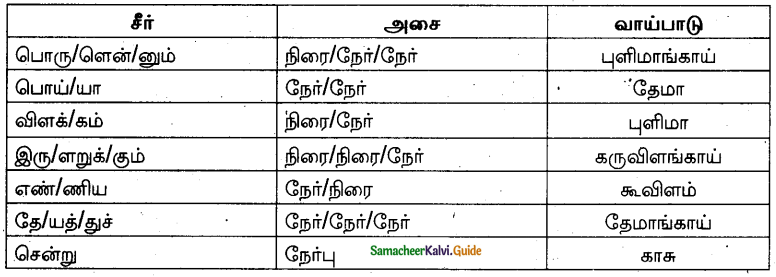
Question 37.
பிறிதுமொழிதல் அணி – விளக்குக.
Answer:
அணிவிளக்கம்:
கவிஞர் ஒரு செய்யுளில் உவமையை மட்டும் கூறி உவமேயத்தைப் பெற வைப்பது பிறிதுமொழிதல் அணியாகும்.
(எ.கா.) “பீலிபெய் சாகாடும் அச்சிறு அப்பண்டம்
சால மிகுத்துப் பெயின் .
உவமை:
மிக மென்மையான மயிலிறகை அளவுக்கு அதிகமாய் வண்டியில் ஏற்றினால் மிக வலிமையான அவ்வண்டியின் அச்சு முறிந்து விடும்,
![]()
உவமேயம்:
ஒருவன் வலியனே ஆயினும் அவன் எளியர் என்று பகைவர் மேல் செல்வானாயின் அவர்கள் ஒன்று கூடினால் அவன் வலியறிந்து கெட்டுப்போக நேரிடும் என்னும் உவமேயப் பொருள் பெறப்படுகிறது. அதனால் இது பிறிது மொழிதலணியாகும்.
பகுதி – IV (மதிப்பெண்க ள்: 25)
அனைத்து வினாக்களுக்கும் விடையளிக்க. [5 × 5 = 25]
Question 38. (அ) ஆற்றுப்படுத்துதல் என்பது அன்றைக்குப் புலவர்களையும் கலைஞர்களையும் வள்ளல்களை நோக்கி நெறிப்படுத்துவதாக இருந்தது. அது இன்றைய நிலையில் ஒரு வழிகாட்டுதலாக மாறியிருப்பதை விளக்குக.
Answer:
- ஆற்றுப்படுத்துதல் என்பது வள்ளலை நாடி எதிர்வருபவர்களை அழைத்து யாம்
இவ்விடத்தேச் சென்று இன்னவெல்லாம் பெற்று வருகின்றோம். - நீயும் அந்த வள்ளலிடம் சென்று வளம் பெற்று வாழ்வாயாக என்று கூறுதல் ஆற்றுப்படை ஆகும்.
- ஆற்றுப்படுத்துதல் என்பது இன்றைய நிலையில் ஒரு வழிகாட்டுதலாக இருக்கிறது.
- தன்னிடம் இல்லை என்றோ அல்லது தெரியாது என்றோ கூறாமல் யார் வந்தாலும் அவர்களுக்கு வழிகாட்டுதலாகவும் இருக்கிறது.
- அவர்களுக்கு அறிவுரை கூறி அவர்களை வழிகாட்டுகின்றனர். அன்றைய ஆற்றுப்படுத்துதல் இன்றைய வழிகாட்டுதலாக மாறியுள்ளது.
- இது ஒவ்வொரு நிலையிலும் மாற்றம் அடைந்துள்ளது. உதவி தேவைப்படுபவர்களுக்கு பெரும் உதவியாக இருந்து வருகிறது.
- இதுவே இன்றைய ஆற்றுப்படுத்துதல் ஆகும்.
(அல்லது)
(ஆ) காலக்கணிதம் கவிதையில் பொதிந்துள்ள நயங்களைப் பாராட்டி எழுதுக.
Answer:
கவிஞன் யானோர் காலக் கணிதம்
கருப்படு பொருளை உருப்பட வைப்பேன்!
புவியில் நானோர் புகழுடைத் தெய்வம்
பொன்னினும் விலைமிகு பொருளென் செல்வம்!
இவைசரி யென்றால் இயம்புவதென் தொழில்
இவைதவ றாயின் எதிர்ப்பதென் வேலை!
ஆக்கல் அளித்தல் அழித்தல் இம் மூன்றும்
அவனும் யானுமே அறிந்தவை, அறிக! (- கண்ணதாசன் )
கருத்து:
நான் தான் காலக் கணிதன் கருப்படும் பொருளை உருப்படவைப்பேன்! புவியில் நல்லவர்கள் பலபேர் இருக்கின்றனர். பொன்னும் விலைமிகு பொருளும் இருக்கிறது. அது செல்வம், இதுசரி, இது தவறு என்று சொல்வது என் வேலை, செய்வது தவறாயின் எதிர்ப்பது என் வேலை சரி என்றால் புகழ்வது என் தொழில். ஆக்கல் காத்தல், அழித்தல் இம்மூன்றும் இறைவனும் நானும் மட்டுமே அறிந்த தொழில்களாகும்.
எதுகை: செய்யுளின் இரண்டாம் எழுத்து ஒன்றிவரத் தொடுப்பது எதுகை.
கவிஞன், புவியில்
மோனை: செய்யுளில் முதல் எழுத்து ஒன்றிவரத் தொடுப்பது மோனை.
கவிஞன், காலம், கணிதம், கருப்படு
முரண்: சரி x தவறு, ஆக்கல் x அழித்தல்
சொல் நயம்: கவிஞன் யானோர் காலக் கணிதம்
கருப்படு பொருளை உருப்பட வைப்பேன்
என்ற சொற்றொடர்களை அமைத்துப் பாடலுக்குச் சிறப்புச் சேர்த்துள்ளார்.
(எ.கா) தெய்வம் எனத் தன்னைக் கூறும் கவிஞர் புகழுடைத் தெய்வம் என்ற சொற்றொடரைக் கையாளும் நயம் படித்து இன்புறத்தக்கது.
பொருள் நயம்: ஆக்கல் அளித்தல் அழித்தல் இம்மூன்றும்
அவனும் யானுமே அறிந்தவை
என்றும் ஆழ்ந்த பொருள் சுவை உடையது (எ.கா) தன் செல்வம் எது எனக் கூற வந்த கவிஞர், பொன் விலை உயர்ந்தது. அதைக் காட்டிலும் விலை உயர்ந்த கவிதைப்பொருளே என் செல்வம் எனக் கூறியிருக்கும். இக்கவிதையின்
பொருள்நயம் போற்றுதற்குரியது.
![]()
Question 39.
(அ) அலுவலக உதவியாளர் பணிக்கு தன்விவரப் பட்டியல் ஒன்றைத் தயார் செய்க.
Answer:
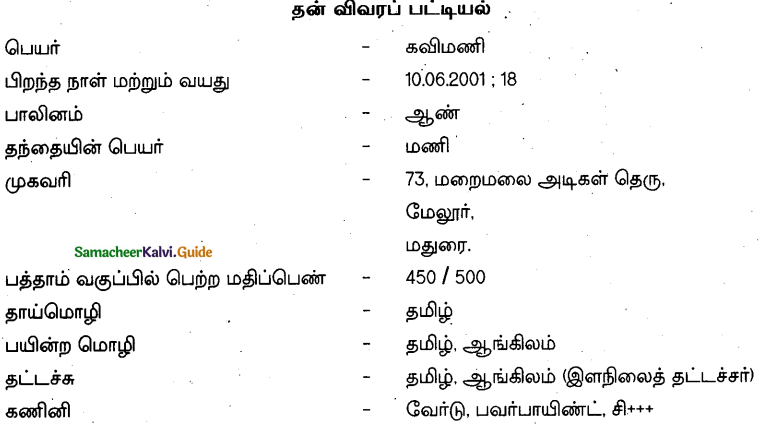
மேற்கண்ட விவரங்கள் அனைத்தும் உண்மையென உறுதி கூறுகிறேன். தங்கள்’ நிறுவனத்தில் உதவியாளர் பணி தந்தால் என் பணியைச் சிறப்பாகச் செய்வேன் என உறுதி கூறுகிறேன்.
நன்றி,
இடம் : மதுரை
தேதி : 18.04.2019
இங்ஙனம்,
தங்கள் உண்மையுள்ள,
கவிமணி.
(அல்லது)
(ஆ) உங்கள் பள்ளியில் நடைபெறும் நாட்டுநலப்பணித்திட்ட முகாமின் தொடக்க விழாவில் மாணவர்களுக்கு வாழ்த்துரை வழங்க உரை ஒன்றை உருவாக்கித் தருக.
Answer:
இங்கு வந்திருக்கும் அனைவருக்கும் வணக்கம்.
எம்பள்ளியின் நாட்டு நலப்பணித் திட்டமுகாம் தொடக்க விழாவிற்கு வந்திருக்கும் அனைவரையும் வணங்குகிறேன்.
மாணவர்களின் மனதில் நாட்டை பற்றிய அக்கறை வளர வேண்டும். “ கடமையைச் செய் பலனை எதிர்பாராதே” அவர்களின் கடமைகளை உணரச் செய்ய வேண்டும். அப்போதுதான் பொறுப்பான சமுதாயம் வளரும். மாணவர்களின் எண்ணங்கள் உயர்ந்ததாக இருக்க வேண்டும். நாட்டின் மீது அக்கறைக் கொள்ள வேண்டும். சுற்று சூழலை சுத்தமாக வைத்துக் கொள்ள வேண்டும். இந்த நாட்டுநலப்பணித் திட்டத்தில் பங்கு கொண்ட மாணவர்கள் அனைவரும் மிக சிறப்பாக தங்கள் பணிகளைச் செய்து காட்டினர். ஒவ்வொரு மாணவனும் ஆர்வமாகவும் சுறுசுறுப்பாகவும் இருப்பதைப் பார்த்தால் நம் நாடு விரைவில் வல்லரசாகும் என்பதில் ஐயமில்லை. வாய்ப்புக்கு வழிகொடுத்த அனைவருக்கும் வணக்கம்.
![]()
Question 40.
படம் உணர்த்தும் கருத்தை நயமுற ஐந்து தொடர்களில் எழுதுக.
Answer:
விருப்புடன் செய்திடு ஈகை
வெறுப்புகள் வேண்டாம் தம்பி
ஒரு பிறவியில் செய்திடும் நன்மை
ஏழு பிறவிகள் தொடர்ந்திடுமாமே!
வாழ்த்துவோர் வாழ்த்தட்டும்
வானமும் வையமும் என்றும்
உன் குணம் போற்றட்டுமே!
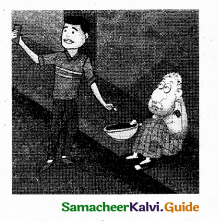
Question 41.
நூலக உறுப்பினர் படிவம் நிரப்புக.
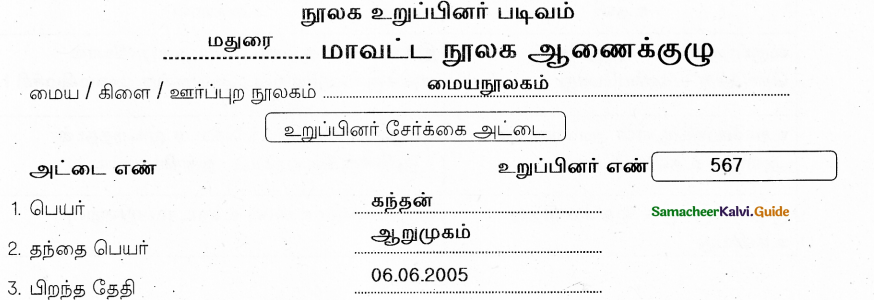
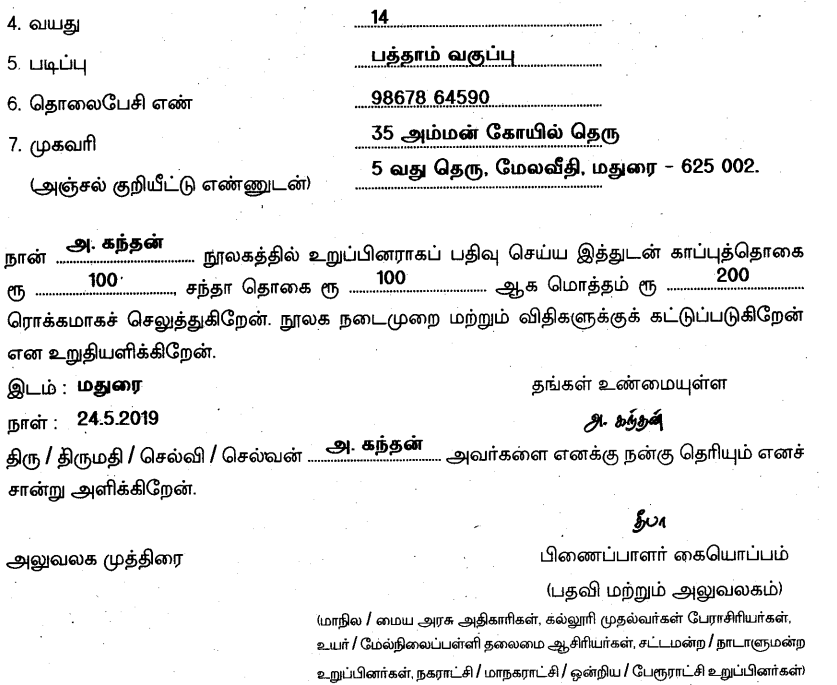
Question 42.
(அ) ஒவ்வொரு சூழலிலும் ஒருவருக்கு ஒருவர் உதவி செய்தபடி இருக்கிறார்கள்; உதவி பெற்றபடியும் இருக்கிறார்கள்; சில உதவிகள் அவர்கள் மீதுள்ள அன்பினால் செய்கிறோம்; சில உதவிகள் இரக்கத்தால் செய்கிறோம். தொடர்வண்டியில் பாட்டுப் பாடிவரும் ஒருவருக்கு நம்மையறியாமல் பிச்சை போடுகிறோம். தொல்லை வேண்டாம் என்று கருதி, வேண்டாவெறுப்போடு சில இடங்களில் உதவி செய்கிறோம்!
நீங்கள் செய்த, பார்த்த உதவிகளால் எய்திய மனநிலையை எழுதுக.
Answer:
உதவி
- வகுப்பறையில் எழுதுகோல் கொடுத்து உதவியபோது
- உறவினருக்கு என் அம்மா பணம் அளித்து உதவியபோது
- முதியவருக்குக் காசுகொடுத்து உதவியது
மனநிலை :
- இக்கட்டான சூழலில் செய்த உதவியால் எனக்கு மனநிறைவு ; அவருக்கு மனமகிழ்ச்சி!
- கல்லூரிப் படிப்பைத் தொடர முடிந்ததால் உறவினருக்கு ஏற்பட்ட நன்றியுணர்வு !
- ஒரு வேளை உணவு உண்ட மனநிறைவு
(அல்லது)
(ஆ) மொழிபெயர்க்க.
Today women in India occupy challenging positions. There are women pilots and women serve the armed forces too. There are successful IAS and IPS officers. Kiran Bedi is an example for successful police officer. There are women chief ministers, M.P.s and M.L.A.S. Our constitution guarantees equal rights to women. In Tamil Nadu, the right of inheritance has been given to women. Education and employment has been made a basic necessity for women. Though there are many progresses in the lives of women, still the other side of the coin is noteworthy and terrific. Dowry death and Eve teasing still prevails. Female baby is still considered a burden and female infanticide is still in existence. Male chauvinism is hurting women. Sania Mirza, Kalpana Chawla, Sunitha Williams and many such women add glory to womanhood. Government must give 50% reservations to women in higher education and career choice.
Answer:
விடை :
இன்றைய பெண்கள் சவாலை எதிர் கொள்ளும் பணிகளைப் புரிகின்றனர். விமான
ஓட்டியாகவும் போர்ப்படையிலும் பணி புரிகின்றனர். IAS மற்றும் IPS அதிகாரிகளாக வெற்றி வாகை சூடியுள்ளனர். உதாரணமாக கிரன் பேடி என்பவர் சாதனை படைத்த காவல் பெண் அதிகாரி ஆவார். முதலமைச்சராகவும், M.P மற்றும் M.L.A ஆகவும் உள்ளனர். நம் தேசத்தின் அரசியல் திட்ட சட்டம் பெண்களுக்கு சம உரிமை அளிக்கிறது. தமிழ் நாட்டில் பெண்களுக்குச் சொத்துரிமை அளிக்கப்பட்டு உள்ளது. கல்வியும், பணியும், பெண்களுக்கு இன்றியமையாததாக இன்று உள்ளது. பெண்களுக்குச் சம உரிமையும் முன்னேற்றமும் இருப்பினும் மறுபக்கம் இன்றளவும் கவனத்துக்குரியதாகவும், பயங்கரமாகவும் இருக்கிறது. வரதட்சணை தொல்லைகளும், பெண்களை ஏளனம் செய்வதும் நடந்த வண்ணமே உள்ளன. பெண் குழந்தையைப் பாரமாகக் கருதி அதைக் கொலைசெய்யும் நிலை இன்றளவும் உள்ளது. ஆண் ஆதிக்கம் பெண்களை காயப்படுத்திக் கொண்டு தான் இருக்கிறது. P.V. சிந்து, கல்பனா சாவ்லா, சுனிதா வில்லியம்ஸ் போன்ற பெண்களினால் பெண் குலத்திற்குப் பெருமை சேர்க்கும் வகையில் உள்ளனர். பெண்களுக்கு அரசாங்கம் 50% சலுகையைக் கல்வியிலும் மற்றும் வேலை வாய்ப்புகளிலும் அளிக்க வேண்டும்.
![]()
பகுதி – V (மதிப்பெண்கள்: 24)
அனைத்து வினாக்களுக்கும் விரிவாக விடையளிக்க. [3 × 8 = 24]
Question 43.
அ) சங்க இலக்கியங்கள், காட்டும் அறங்கள் இன்றைக்கும் தேவையானவையே
என்பதற்குச் சில எடுத்துக்காட்டுகள் தருக.
Answer:
அறத்தில் வணிக நோக்கம் கொள்ளாமை:
அறம் செய்வதில் வணிக நோக்கம் இருக்கக்கூடாது என்பது சங்ககால மக்களின் கருத்தாக இருந்தது. இப்பிறப்பில் அறம் செய்தால் அதன் பயனை மறுபிறப்பில் பெறலாம் என்ற வணிக நோக்குக் கூடாது எனக் கூறப்பட்டது.
“இம்மைச் செய்தது மறுமைக்கு ஆம் எனும்
அறவிலை வணிகன் ஆஅய் அல்லன்” – புறம்
எனச் சங்ககால வள்ளல்களில் ஒருவரான ஆய்பற்றி ஏணிச்சேரி முடமோசியார் குறிப்பிட்டுள்ளார். நோக்கமின்றி அறம் செய்வதே மேன்மை தருவது என்பது இதில் உணர்த்தப்பட்டுள்ளது.
அரசியல் அறம் :
மன்னர்களுடைய செங்கோலும் வெண்கொற்றக்குடையும் அறத்தின் குறியீடுகளாகப் போற்றப்பட்டன. அரசன் செங்கோல் போன்று நேரிய ஆட்சியை மேற்கொள்ள வேண்டும் என்பது பல பாடல்களில் வலியுறுத்தப்பட்டுள்ளது. நீர்நிலை பெருக்கி நிலவளம் கண்டு உணவுப்பெருக்கம் காண்பதும் அதனை அனைவருக்கும் கிடைக்கச் செய்வதும் அரசனின் கடமையாகச் சொல்லப்பட்டது. குற்றங்களை, அறத்தின் அடிப்படையில் ஆராய்ந்து தண்டனை வழங்க வேண்டும் என்கிறார் ஊன் பொதிப் பசுங்குடையார். அரசன் அறநெறியில் ஆட்சிசெய்வதற்கு அமைச்சரும் உதவினர். நன்றும் தீதும் ஆய்தலும், அன்பும் அறனும் காத்தலும் அமைச்சர் கடமை என்கிறது மதுரைக்காஞ்சி.. ‘செம்மை சான்ற காவிதி மாக்கள்’ என்று அமைச்சர்களை மாங்குடி மருதனார் போற்றுகிறார்.
![]()
போர் அறம்:
தமிழர், போரிலும் அறநெறிகளைப் பின்பற்றினர். போர் அறம் என்பது வீரமற்றோர். புறமுதுகிட்டோர், சிறார், முதியோர் ஆகியோரை எதிர்த்துப் போர் செய்யாமையைக் குறிக்கிறது. போரின் கொடுமையிலிருந்து பசு, பார்ப்பனர், பெண்கள், நோயாளர், புதல்வரைப் பெறாதவர் ஆகியோருக்குத் தீங்கு வராமல் போர் புரிய வேண்டும் என்று ஒரு பாடல் கூறுகிறது. தம்மைவிட வலிமை குறைந்தாரோடு போர் செய்வது கூடாது என்பதை ஆவூர் மூலங்கிழார் குறிப்பிட்டிருக்கிறார்.
“எறியார் எறிதல் யாவணது எறிந்தார்
எதிர்சென்று எறிதலும் செல்லான்” – புறம்
இத்தகைய அறநிலைகள் இன்றைக்கும் தேவையானவை ஆகும்.
(அல்லது)
ஆ) தமிழின் சொல்வளம் பற்றியும் புதிய சொல்லாக்கத்திற்கான தேவை குறித்தும் தமிழ் மன்றத்தில் பேசுவதற்கான உரைக் குறிப்புகளை எழுதுக.
Answer:
முன்னுரை:
கால வெள்ளத்தில் கரைந்துபோன மொழிகளுக்கிடையில் நீந்தி தன்னை நிலை நிறுத்திக் கொண்டுள்ளது தமிழ். சொல்வளம் இலக்கியச் செம்மொழிகளுக்கெல்லாம் பொது என்றாலும் தமிழ் மட்டுமே அதில் தலை சிறந்ததாகும். தமிழின் சொல் வளத்தை நாம் பலதுறைகளிலும் காணலாம்.
தமிழின் சொல் வளம்:
ஆங்கிலம் போன்ற மொழிகளில் இலையைக் குறிக்க ஒரே ஒரு சொல் மட்டுமே உள்ளது. ஆனால் தமிழ்மக்கள் இலையை அதன் வன்மை, மென்மை, இவற்றைக் கொண்டு இலை, தோகை, ஓலை என பாகுபாடு செய்துள்ளனர். இதுமட்டுமன்றி தாவரங்கள், மணிவகை, இளம்பயிர்வகை, காய்கனி வகை, அடி, கிளை கொழுந்து என அனைத்து உறுப்புகளுக்கும் சொற்களைப் பகுத்து வைத்துள்ளனர்.
![]()
பூவின் நிலைகளைக் குறிக்கும் சொற்கள்:
அரும்பு: பூவின் தோற்றநிலை போது, பூ விரியத் தொடங்கும் நிலை மலர், பூவின் மலர்ந்த நிலை, வீ: மரம், செடியிலிருந்து பூ கீழே விழுந்த நிலை செம்மல், பூ வாடின நிலை.
தமிழின் பொருள் வளம்:
தமிழ்நாடு எத்துணைப் பொருள் வளமுடையது என்பது அதன் வினை பொருள் வகைகளை நோக்கினாலே விளங்கும். தமிழ் நாட்டு நெல்லில் செந்நெல் வெண்ணெல், கார்நெல் என்றும், சம்பா, மட்டை, கார் என்றும் பல வகைகள் உள்ளன. அவற்றில் சம்பாவில் மட்டும் ஆவிரம் பூச்சம்பா, ஆனைக் கொம்பன் சம்பா, குண்டு சம்பா, குதிரை வாலிச்சம்பா, சிறுமணிச்சம்பா, சீரகச்சம்பா முதலிய அறுபது. உள் வகைகள் உள்ளன. இவற்றோடு வரகு, காடைக்கண்ணி குதிரைவாலி முதலிய சிறு கூலங்கள் தமிழ் நாட்டிலன்றி வேறெங்கும் விளைவதில்லை.
முடிவுரை:
பண்டைத் தமிழ் மக்கள் தனிப்பெரும் நாகரிகத்தை உடையவராக இருந்திருக்கின்றனர். ஒரு நாட்டாரின் அல்லது இனத்தாரின் நாகரிகத்தை அளந்தறிவதற்கு உதவுவது மொழியேயாகும். ஆகவே “நாடும் மொழியும் நமதிரு கண்கள்” என்ற கூற்றின்படி பொருட்களைக் கூர்ந்து நோக்கி நுண்பொருட் சொற்களை அமைத்துக் கொள்வது நம் தலையாய கடமையாகும்.
Question 44.
(அ) அனுமான் ஆட்டத்தைக் கூறுக.
Answer:
- திடீரென்று மேளமும் நாதசுரமும் துரித கதியில் ஒலிக்கத் தொடங்கின.
- எதற்கென்று தெரியாமல் கூட்டம் திகைத்துப் பந்தலை நோக்குகையில் பெருங்குரல் எழுப்பியபடி அனுமார் பந்தல் கால் வழியாகக் கீழே குதித்தார்.
- அனுமார் வாலில் பெரிய தீப்பந்தம். ஜ்வாலை புகைவிட்டுக் கொண்டு எரிந்தது. கூட்டம் தானாகவே பின்னால் நகர்ந்தது.
- அனுமார் கால்களைத் தரையில் பதித்து உடம்பை ஒரு குலுக்குக் குலுக்கினார்.
- தீயின் ஜ்வாலை மடிந்து அலை பாய்ந்தது. கைகளைத் தரையில் ஊன்றி அனுமார் கரணமடித்தார்.
- சுருண்ட வால் இவன் பக்கமாக வந்து விழுந்தது.
- கூட்டம் அச்சத்தோடு கத்தியபடி அலைக்கழிந்தது.
- அனுமார் பெரிதாகச் சிரித்துக்கொண்டு நின்றார். அனுமார் நின்றதும் கூட்டம் கொஞ்சம் அமைதியுற்றது.
- முன்நோக்கி நகர்ந்து வந்தது. அனுமார் நேசப்பான்மையோடு சிரித்து வாலை மேலே தூக்கிச் சுற்றினார்.
- தீ வட்டமாகச் சுழன்றது. வேகம் கூடக்கூட, கூட்டம் இன்னும் முன்னால் நகர்ந்து வந்தது.
- இவன் நெருங்கி அனுமார் பக்கம் சென்றான்.
- அனுமார் இன்னொரு பாய்ச்சல் பாய்ந்து வேகமாக ஆட ஆரம்பித்தார்.
வர வர ஆட்டம் துரிதகதிக்குச் சென்றது. பதுங்கியும் பாய்ந்தும் ஆடினார். - ஆட ஆட, புழுதி புகை போல எழுந்தது. கழுத்துமணி அறுந்து கீழே விழுந்தது. • ஒன்றையும் பொருட்படுத்தாமல் ஆட்டத்தில் தன்னை இழந்தவராக ஆடினார்.
- மேளமும் நாதசுரமும் அவர் ஆட்டத்தோடு இணைந்து செல்ல முடியவில்லை.
தடுமாறிவிட்டது - மேல் மூச்சு வாங்க அனுமார் ஆட்டத்தை நிறுத்தினார். மேளமும் நாதசுரமும் நின்றன.
- அயர்ச்சியோடு மேளக்காரன் தோளிலிருந்து தவுலை இறக்கிக் கீழே வைத்தான்.
- ஆட்டம் முடிந்தது. தீர்மானமாகியது போல எஞ்சி இருந்த கூட்டமும் அவசர அவசரமாகக் கலைய ஆரம்பித்தது.
(அல்லது)
(ஆ) உரைநடையின் அணிநலன்களை சுருக்கி எழுதுக.
Answer:
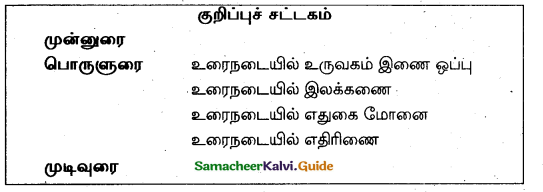
முன்னுரை:
சங்க இலக்கியம் நம் பாட்டனார் தோப்பு. இடைக்கால இலக்கியம் நம் தந்தையார் தோட்டம். இக்கால இலக்கியம் நம் பூங்கா. இவை அனைத்தின் நயங்களையும் ஒன்று சேர்த்து உரைநடையின் அணிநலன்களாகக் காண்போம்.
உரைநடையில் உருவகம் இணை ஒப்பு:
தற்பொழுது முகநிலவில் வியர்வை முத்துகள் துளிர்த்தன என்று உருவகமாக எழுதுகிறார்கள். களம்புகத் துடித்து நின்ற உனக்கு வெற்றிச்சாறு கிடைத்துவிட்டது, உண்டு மகிழ்ந்தாய், உன் புன்னகைதான் அதற்குச் சான்று இது அறிஞர் அண்ணாவின் உரைநடை.
எடுத்துக்காட்டு உவமை அணியை உரைநடையில் பயன்படுத்துகையில் இணை நட்பு என்கிறோம். ஊர் கூடிச் செக்குத் தள்ள முடியுமா? எனக் கேட்கிறார்கள் ஊர் கூடின பிறகுதான் செக்குத் தள்ள வேண்டும் என்று காத்திருப்பவர்களின் காரியம் கைகூடாது. புரோகிதருக்காக அமாவாசை காத்திருப்பதில்லை என்று எழுத்தாளர் வ. ராமசாமி மழையும் புயலும் என்ற நூலில் குறிப்பிட்டுள்ளார்.
உரைநடையில் இலக்கணை:
“சோலையில் புகுவேன்; மரங்கள் கூப்பிடும்; விருந்து வைக்கும், ஆலமர நிழலில் அமர்வேன்; ஆல், ‘என் விழுதைப் பார். அந்த அரசுக்கு இஃது உண்டா ?’ என்னும். அரசு கண்ணிற்படும். ‘யான் விழுதின்றி வானுற ஓங்கி நிற்கிறேன், என்னை மக்கள் சுற்றிச் செல்கிறார்கள், காண்’ என்னும், வேம்பு, என்நிழல் நலஞ்செய்யும். என் பூவின் குணங்களைச் சொல்கிறேன் வா’ என்னும், அத்தி, நாகை, விளா, மா, வில்வம் முதலிய மரங்கள் விளியாமலிருக்குமோ? சிந்தனையில் அவைகளின் நுட்பங்கள் விளங்கும். மலை என்னை அடிக்கடி அழைக்கும். மலைமீது இவர்வேன், ஓரிடத்தில் அமர்வேன்; மேலும் கீழும் பார்ப்பேன்; சுற்றுமுற்றும் பார்ப்பேன். மனம் அமைதி எய்தும் “. எங்கள் காலத் தமிழ்த்தென்றல் திரு. வி. கலியாணசுந்தரனார் இப்படி எழுதியிருக்கிறார்.
உரைநடையில் எதுகை மோனை:
“தென்றல் அசைந்துவரும் தென்தமிழ் நாட்டில் அமைந்த திருக்குற்றாலம், மலைவளம் படைத்த பழம்பதியாகும். அம்மலையிலே, கோங்கும் வேங்கையும் ஓங்கி வளரும்; குரவமும் முல்லையும் இத்தகைய மலையினின்று விரைந்து வழிந்திறங்கும் வெள்ளருவி வட்டச் சுனையிலே வீழ்ந்து பொங்கும்பொழுது சிதறும் நீர்த் திவலைகள் பாலாவிபோற் பரந்தெழுந்து மஞ்சினோடு சேர்ந்து கொஞ்சிக் குலாவும் ” என்று சொல்லின் செல்வர் இரா. பி. சே. தமிழின்பம் என்னும் நூலில் எழுதியுள்ளார்.
உரைநடையில் எதிரிணை:
அமைத்து எழுதுவோம்…. இதனை எதிரிணை இசைவு என்கிறோம். குடிசைகள் ஒரு பக்கம்; கோபுரங்கள் மறுபக்கம்; பசித்த வயிறுகள் ஒருபக்கம். புளிச்சேப்பக்காரர்கள் மறுபக்கம்; மெலிந்த எலும்புக்கூடுகள். ஒருபக்கம் பருத்த தொந்திகள் மறுபக்கம்; கேடுகெட்ட இந்தச் சமுதாயத்திற்கு என்றைக்கு விமோசனம்? தோழர்களே, சிந்தியுங்கள்!’ என்று தோழர் ப. ஜீவானந்தம் எழுதியிருப்பது இதற்கு நல்ல எடுத்துக்காட்டு!’ முடிவுரை:
பேசினால் உரையாடல், எழுதினால் உரைநடை, இன்றைய உரைநடையின் வளர்ச்சியோ அளவற்றது. கட்டுரை, சிறுகதை, புதினம் இவையெல்லாம் இன்றைய உரைநடையின் இலக்கிய வடிவங்களாகத் திகழ்கின்றன. இவற்றைப் படித்து நம் அறிவை வளப்படுத்திக் கொள்வோம்.
![]()
Question 45.
(அ) குறிப்புகளைப் பயன்படுத்திக் கட்டுரை ஒன்று தருக.
முன்னுரை – இளமைப் பருவம் – கல்வி – கனவு நனவானது – முதல் பயணம் – கல்பனாவின் ஆர்வம் – இரண்டாம் பயணம் – முடிவுரை.
Answer:
விண்வெளியும் கல்பனா சாவ்லாவும்
முன்னுரை:
விண்வெளிக்குப் பயணம் செய்த இந்தியாவின் முதல் பெண்மணி என்ற பெருமைக்குரியவர் கல்பனா சாவ்லா. நடுத்தரக் குடும்பத்தில் பிறந்து உலகமே வியந்த விண்வெளி வீராங்கனையாக வாழ்ந்த கல்பனா சாவ்லா அமெரிக்காவின் கொலம்பியா ஓடத்தில் இருந்து விண்வெளிக்குப் பறந்து ஆராய்ச்சிகளை மேற்கொண்டவர்.
இளமைப் பருவம்:
இந்தியாவின் ஹரியானா மாநிலத்தில் 1961 ம் ஆண்டு ஜுலை 1 ஆம் தேசி கர்னாஸ் என்ற ஊரில் பிறந்தார் கல்பனா. வீட்டின் நான்கு பிள்ளைகளில் அவர்தான் கடைக்குட்டி அவர் தந்தை ஒரு வியாபாரி, தாய் இல்லத்தரசி பொம்மை வைத்து விளையாடும் வயதில் கல்பனாவுக்குப் பிடித்த பொழுதுபோக்கு விமான ஓவியங்கள் தீட்டி அழகு பார்ப்பது விமானங்களின் சத்தம் கேட்டாலே வீட்டில் இருந்து தெருவுக்கு ஓடிவந்து அந்த அலுமினியப் பறவை, புள்ளியாக மறையும் வரை கண்கள் சுருக்கிப் பார்த்துக்கொண்டே நிற்கும் குழந்தைகளில் ஒருவர்தான் கல்பனாவும்.
கல்வி :
கர்னாவில் உள்ள அரசுப் பள்ளியில் ஆரம்பக் கல்வியை முடித்த கல்பனாவுக்கு அந்த வயதிலேயே விண்வெளி வீரராக வேண்டும் என்ற இலக்கு மனதில் பதிந்துவிட்டது. சண்டிகரில் உள்ள பஞ்சாப் பொறியியல் கல்லூரியில் விமானப் பொறியியல் பயில விரும்பினார். ஆனால் அது அப்போது ஆண்களின் படிப்பாக இருந்ததால் பெற்றோர் அனுமதிக்கவில்லை என்றாலும் கல்பனாவின் பிடிவாதத்தை அவர்களால் மாற்ற முடியவில்லை. அந்தக் கல்லூரியில் பொறியியல் பட்டம் பெற்ற கல்பனாவை 1982 ல் அமெரிக்கா வரவேற்றது. 1984 ஆம் ஆண்டு டெக்காஸ் விண்வெளி பொறியியல் துறையில் முதுகலைப்பட்டம் பெற்றார் கல்பனா. நான்கு ஆண்டுகள் கழித்துக் கொலோரடோ பல்கலைக்கழகத்தில் விமானப் பொறியியல் துறையில் முனைவர் பட்டம் பெற்றார்.
கனவு நனவானது:
1993 ம் ஆண்டு ஒரு தனியார் நிறுவனத்தில் ஆய்வு விஞ்ஞானியாகச் சேர்ந்தார். அதற்கு அடுத்த ஆண்டே அவரின் விண்வெளி வீரர் கனவு நனவாகத் தொடங்கியது. நாஸாவில் விண்வெளி வீரர் பயிற்சி பெறுவதற்கு விண்ணப்பித்திருந்த சுமார் 3000 பேரில் ஆறு பேர் மட்டும் தேர்வானார்கள். அவர்களுள் கல்பனாவும் ஒருவர். ஜான்ஸன் விண்வெளி தளத்தில் பல்வேறு உடல் மருத்துவ பரிசோதனைகள், கடுமையான நேர்காணல்கள் ஆகியவற்றைக் கடந்து வெற்றிகரமாகத் தேர்ச்சிப் பட்டியலில் இடம் பிடித்தார்.
![]()
முதல் பயணம்:
1995 ஆம் ஆண்டு பயிற்சிகள் முடிந்து விண்வெளி வீராங்கனையாகத் தகுதி பெற்ற கல்பனாவின் முதல் விண்வெளிப் பயணம் 1997 ஆம் ஆண்டு நவம்பர் 19 ஆம் தேதி நிகழ்ந்தது. ஆறு வீரர்களுடன் கொலம்பிய விண்வெளி ஊர்தியான எஸ்.டி.எஸ் 87-ல் பயணம் செய்வதற்குத் தேர்வு செய்யப்பட்ட கல்பனாவுக்கு அதில் ஆராய்ச்சி குறித்த முக்கியப் பொறுப்புகளும் தரப்பட்டன. பூமியை சுமார் 252 தடவை சுற்றிய அந்த விண்கலத்தில் சுமார் 10 மில்லியன் மைல் தொலைவு பயணித்த கல்பனா. சகவிண்வெளி வீரர்களுடன் வெற்றிகரமாகப் பூமிக்குத் திருப்பினார்.
கல்பனாவின் ஆர்வம்:
விமானம் மற்றும் கிளைடர்களை ஓட்டக் கற்றுக் கொடுக்க தகுதிச் சான்றிதழ் பெற்றதோடு மட்டுமல்லாமல் ஓட்டவும் அனுமதி பெற்றிருந்தார் கல்பனா. கொலம்பியா விண்வெளிப் பயணம் மேற்கொள்ளும் முன் கல்பனா முழுமனதோடு ஒரு காரியத்தில் ஈடுபடுபவர்களைப் பார்த்தால் எனக்கும் ஊக்கம் ஏற்படும் என்றார். ஆராய்ச்சியாளர்களின் சுயசரிதைகளை விரும்பிப் படிக்கும் அவர், தன் ஆசிரியர்களுக்கு எப்போதும் தன் நன்றிகளைத் தெரிவித்தபடி இருப்பார்.
இரண்டாம் பயணம்:
முதல் பயணத்தை வெற்றிகரமாக முடித்த கல்பனா. பிறகு அதே கொலம்பியா விண்கலத்தில் 2003 ஜனவரி 16 ஆம் தேதி ஆறு விண்வெளி வீரர்களுடன் மீண்டும் விண்ணுக்குப் பயணித்தார். பல விண்வெளி ஆராய்ச்சிகளை மேற்கொண்ட அவர்கள் பயணத்தை முடித்துக் கொண்டு வெற்றிகரமாக திட்டமிட்டபடி பிப்ரவரி ஒன்றாம் தேதி தரையிறங்க ஆயத்தமானார்கள். பூமியைத் தொட 16 நிமிடங்களே இருந்த நிலையில் அந்த சோக சம்பவம் நிகழ்ந்தது. கொலம்பியா விண்கலம் வெடித்துச் சிதறியது 41 வயது கல்பனா தேவதையாக விண்ணில் கலந்தார்.
முடிவுரை:
இந்திய அரசு கல்பனா சாவ்லாவின் சாதனைகளை நினைவு கூறும் வகையில் 2011 ம் ஆண்டு முதல் ஆண்டு தோறும் வீரதீரச் சாதனைகள் புரிந்த பெண்களுக்குக் கல்பனா சாவ்லா விருது வழங்கி கவுரவப்படுத்துகிறது. அந்த விண்வெளி தேவதை நம் வீட்டின் பல குட்டி தேவதைகளுக்குப் பிரியமான ரோல்மாடல்!
(அல்லது)
ஆ) குறிப்புகளைப் பயன்படுத்திக் கட்டுரை ஒன்று தருக.
பொதுமை – தகைமை – முறைமை – நிறையுடைமை – சுட்டுந்தன்மை – அறிவாண்மை – வளமை – மறுமை.
Answer:
உலகப் பொதுமறை பொதுமை :
இது தமிழிற்குக் கிடைத்த அரிய நீதி நூல். கரும்பென்றால் அடி இனிக்கும் எனக் கூறலாம். இதுவோ கற்கும் இடமெல்லாம் சுவையினைத் தருவதாகும்.
“எம்மதமும் எவ்வினமும் எந்நாளும்
சம்மதம் என்று ஏற்கும் தமிழ் வேதம்”
![]()
எனும் சுத்தானந்தரின் கூற்றின்படி எக்காலத்திற்கும் பொருத்தமுற அமைக்கப்பட்ட அழியாக் காவியம்.
தகைமை:
சிறு அடிகளில் உலகளந்த தகைமை இதன் பெருமையாகும். திருக்குறள் பல்வேறு அடைமொழிகளால் உத்தரவேதம், பொய்யாமொழி, வாயுறை வாழ்த்து, தமிழ்மறை எனக் குறிக்கப்படுகிறது. திருவள்ளுவரின் வேறு பெயர்கள் நாயனார், தேவர், முதற்பாவலர், மாதானுபங்கி, தெய்வப்புலவர், செந்தாப்போதார், பெருநாவலர் எனப் பலவாகும்.
முறைமை :
திருக்குறளானது 10 குறளினுக்கு ஒரு அதிகாரமாக 133 அதிகாரங்களைக் கொண்டது. அதிகார வரிசைகள் எல்லாம் பிற்காலத்தில் அமைக்கப்பட்டவை. மூன்று பிரிவுகளாக அறம், பொருள், இன்பம் எனப் பிரிக்கப்பட்டுள்ளது. அறத்துப்பால் 38 அதிகாரமும், பொருட்பால் 70 அதிகாரமும், காமத்துப்பால் 25 அதிகாரமுமாக அமைக்கப்பட்டுள்ளன. திருக்குறளின் உரையாக மணக்குடவர், காளிங்கர், பரிமேலழகர், பரிதியார், பரிப்பெருமாள் என்பவர்கள் உள்பட பதின்மர் உரை எழுதியுள்ளார். இதில் பரிமேலழகர் உரையே சிறப்பாகக் கருதப்படுகிறது.
நிறையுடைமை:
வாழ்க்கையின் நோக்கங்களைச் செய்யுளுக்கு இலக்காக்கி வைத்த பெருந்தகையார். உயர்ந்த தத்துவங்களை ஈரடியினில் அடக்கியவர். அதனால் பாரதியார்,
“வள்ளுவன் தன்னை உலகினுக்கே தந்து
வான்புகழ் கொண்ட தமிழ்நாடு” – எனப் போற்றுகின்றார்.
உலக மொழிகளில் பைபிளுக்கு அடுத்தபடியாக பல மொழிகளில் மொழி பெயர்க்கப்பட்டுள்ளது. முதன் முதலில் இலத்தீன் மொழியில் மொழி பெயர்க்கப்பட்டது. ஆங்கிலத்தில் மொழி பெயர்த்தவர் ஜி.யு.போப் ஆவார். தமிழின் முதல் எழுத்தாகிய அ ‘ என்பதில் அகர முதல ‘ எனும் குறளில் தொடங்கி தமிழின் இறுதி எழுத்தாகிய ‘ன்’ என்பதற்கு 1330-வது குறளின் இறுதிச் சொல்லாகப் பெறின்’ எனும் சொல் முடிவுச் சொல்லாக அமைக்கப்பட்டுள்ளது.
சுட்டுந்தன்மை :
சங்க காலமானது பொற்காலமாகச் சொல்லப்படினும், கள் குடித்தல், பரத்தையர் தொடர்பு இவை தவறெனக் கூறப்படவில்லை . ஆனால் சங்கம் மருவிய காலத்தில் எழுந்த நூற்களில் நீதி நூற்கள் மிகுதியாயின. நீதி நூற்களில் திருக்குறள் சிறப்பானதாக அமைந்துள்ளது. பொதுவான கருத்துகளான ‘நீரின்றி அமையாது உலகு’ என்பது முதல் ‘ஈன்றாள் பசி காண்பாள் ஆயினும் செய்யற்க சான்றோர் பழிக்கும் வினை’ என்பது வரை மனிதனை வழிநடத்தும் நெறிகளாய் அமைந்துள்ளன.
![]()
அறிவாண்மை :
குடியினால் மக்கள் சிறுமைப்படுபவர் என்பதை ‘கள்ளுண்ணாமை’ எனும் அதிகாரத்தில் தந்து ‘உண்ணற்க கள்ளை’ என அறிவுறுத்தியும், பிறன் பொருளை எடுத்தல் நல்லதல்ல என்பதற்கு ‘கள்ளாமை’ எனும் அதிகாரத்திலும் சுட்டிக் காட்டுகின்றனர். புலால் உண்ணுவதால் யாது பயன் என்பதை,
“தன்னூன் பெருக்கத்திற்குத்தான் பிறிது ஊனுண்பான்
எங்ஙனம் ஆளும் அருள்” – எனக் கூறி
உடலை வளர்க்க பிற ஊனும் தேவையா என வினா எழுப்புகிறார்.
சூதினால் இவ்வுலகம் தவறான வழியில் சென்று பொருளிழப்பதை ‘சிறுமை பல செய்து சீரழிக்கும் சூது’ என அறிவுறுத்துகிறார்.
நெறிமுறைகளைக் கடைப்பிடித்து உணவினை உண்டோமானால் மருந்தென ஒன்று வேண்டாம் என்பதை, ‘மிகினும் குறையினும் நோய் செய்யும்’ எனக்கூறி விழிப்புணர்வினைத் தருகிறார்.
நட்பு பற்றிக் கூறும்போது, ‘உடுக்கை இழந்தவன் கைபோல’ எனும் குறளில், தம் உடையானது அவிழும்போது தன்னுடைய கை நம்மை அறியாமலே சரியாக்குவதைப்போல நட்புடையோர் துன்பப்படும்போது உதவுவது நண்பனின் கடமை என வலியுறுத்துகிறார்.
கல்வி பற்றி கூறும்போது “தொட்டனைத்தூறும் மணற்கேணி” என்கிறார். ஒருவன் படிக்கப் படிக்க அறிவு பெருகும். எதைப்போல எனில் கிணற்றிலிருந்து நீர் எடுத்த பின்னும் சுரப்பது போல காதலாக என உதாரணம் காட்டுகின்றார். இப்பரந்த உலகம் உனதாக ஆக வேண்டுமானால் கிடைத்து விடும். எவ்வாறெனில்,
“ஞாலம் கருதினும் கைக்கூடம் காலம்
கருதி இடத்தாற் செயின்” (- எனச் சொல்லி )
![]()
உள்ளுணர்வுகளைத் தட்டி எழுப்புகிறார்.
மேலும் ஆளுகின்ற மன்னன் எப்போது மதிக்கப்படுவான் எனக் கூறும்போது ‘குடிதழீஇ கோலோச்சும் போது’. அதாவது குடிகளை எண்ணி அவர்களின் கருத்திற்கிணங்க ஆட்சி புரியும் போது மன்னவன் மதிக்கப்படுவான் என்றார்.
பெண்மையைக் கூறும்போது, ‘இல்லதென் இல்லவள் மாண்பு’ என இயம்புகின்றார்.
இவ்வாறு பல்வேறு நிலைகளினில் மக்களுக்கு அறிவாண்மை வெளிப்பட ஆதாரமாய் நிற்கின்றார்.
வளமை :
காலங்களைக் கடந்தாலும் அன்றாட வாழ்விலும், பல இடங்களிலம் பயன்படுத்தும் கருத்துகளாய் அமைந்துள்ளன. சட்டசபையிலும், பாராளுமன்றத்திலும் வரவு-செலவு திட்டத்தினைக் கூறும்போது,
“இயற்றலும் ஈட்டலும் காத்தலும் காத்த
வகுத்தலும் வல்லது அரசு” – என இக்குறளினை
கையாளும் அளவிற்குப் பிற்காலத்தோடு பொருத்தமுற எழுதப்பட்ட ஒப்பற்ற நூலாகும்.
நடைமுறை வாழ்விலும்கூட இவர் கருத்துகள் எண்ணற்குரியது. ‘தொழுத கையுள்ளும் படை ஒடுங்கும்’ எனும் குறள் மூலம் காந்தியடிகளின் இறப்பினை, நமது இழப்பினை நாம் அறியாமலில்லை.
பழமையில்கூட புதுமை காட்டி, குறளினைச் சொல்லும்போது உதடுகள் ஒட்டாத குறளும் உள்ளன. அவை, ‘யாதெனின்’, ‘வசையொழிய’ எனும் குறள்களைக் கூறலாம்.
![]()
மறுமை:
இம்மை மாறி மறுமையாயினும் குறளானது காலங்களைக் கடந்து நிற்கும். இக்காலத்தில் பல்வேறு ஆராய்ச்சி நூல்கள் திருக்குறளிலிருந்து எழுந்துள்ளன. இணையத்தில் (Internet) திருக்குறள் பதிவு செய்யப்பட்டுள்ளது. தமிழக அரசு முன்பு சென்னையில் ‘வள்ளுவர் கோட்டம்’ அமைத்து குறள்களை கற்களில் பொறித்து சிலைகளையும் செதுக்கி வைத்தது. தற்போது குமரிக் கடற்கரையில் திருவள்ளுவருக்கு 133 அடியில் சிலை வைத்துள்ளது. திருவள்ளுவர் பெயரில் விருதுகள் வழங்கி வருகின்றனர். நாணயத்தின் ஒருபுறம் திருவள்ளுவரின் உருவமானது பொறிக்கப்பட்டு வெளியிடப்பட்டுள்ளது. இவ்வாறு காலத்தால் அழியாத புகழைப் பெற்றுள்ளது திருக்குறள்.
















